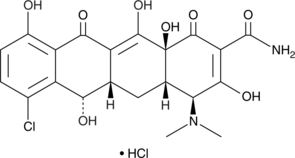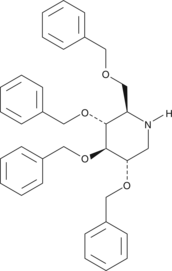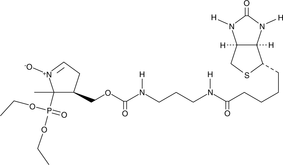Cayman
Showing 17701–17850 of 45550 results
-
Dehydroergosterol is a naturally occurring, fluorescent analog of cholesterol (ex/em = 324/375 nm) that mimics the properties of cholesterol in cell membranes.{32485} It is readily bound by cholesterol-binding proteins and has been used for real-time probing of the sterol environment and to elucidate intracellular sterol trafficking in living organisms.{32485}
Brand:CaymanSKU:19709 -Available on backorder
-
Dehydroergosterol is a naturally occurring, fluorescent analog of cholesterol (ex/em = 324/375 nm) that mimics the properties of cholesterol in cell membranes.{32485} It is readily bound by cholesterol-binding proteins and has been used for real-time probing of the sterol environment and to elucidate intracellular sterol trafficking in living organisms.{32485}
Brand:CaymanSKU:19709 -Available on backorder
-
Dehydroergosterol is a naturally occurring, fluorescent analog of cholesterol (ex/em = 324/375 nm) that mimics the properties of cholesterol in cell membranes.{32485} It is readily bound by cholesterol-binding proteins and has been used for real-time probing of the sterol environment and to elucidate intracellular sterol trafficking in living organisms.{32485}
Brand:CaymanSKU:19709 -Available on backorder
-
Dehydroergosterol is a naturally occurring, fluorescent analog of cholesterol (ex/em = 324/375 nm) that mimics the properties of cholesterol in cell membranes.{32485} It is readily bound by cholesterol-binding proteins and has been used for real-time probing of the sterol environment and to elucidate intracellular sterol trafficking in living organisms.{32485}
Brand:CaymanSKU:19709 -Available on backorder
-
Dehydroevodiamine is an alkaloid that has been isolated from E. rutaecarpa and has anti-inflammatory, antiarrhythmic, hypotensive, and anti-amnesic biological activities.{37668,37669,37670,37671} It inhibits LPS-induced secretion of prostaglandin E2 (PGE2; Item No. 14010) in RAW 264.7 mouse macrophages when used at a concentration of 30 μM.{37668} Dehydroevodiamine (0.1-0.3 μM) reduces the upstroke velocity, action potential amplitude, and contractile force of electrically-stimulated primary human atrial trabeculae.{37669} In vivo, dehydroevodiamine (10 mg/kg) decreases mean arterial blood pressure (MAP) by approximately 30% in rats.{37670} Dehydroevodiamine (1.5 mg/kg) also inhibits amnesia induced by amyloid-β (25-35) (Item No. 24155) and increases latency to step-through in a passive avoidance test in mice.{37671}
Brand:CaymanSKU:25101 - 100 mgAvailable on backorder
-
Dehydroevodiamine is an alkaloid that has been isolated from E. rutaecarpa and has anti-inflammatory, antiarrhythmic, hypotensive, and anti-amnesic biological activities.{37668,37669,37670,37671} It inhibits LPS-induced secretion of prostaglandin E2 (PGE2; Item No. 14010) in RAW 264.7 mouse macrophages when used at a concentration of 30 μM.{37668} Dehydroevodiamine (0.1-0.3 μM) reduces the upstroke velocity, action potential amplitude, and contractile force of electrically-stimulated primary human atrial trabeculae.{37669} In vivo, dehydroevodiamine (10 mg/kg) decreases mean arterial blood pressure (MAP) by approximately 30% in rats.{37670} Dehydroevodiamine (1.5 mg/kg) also inhibits amnesia induced by amyloid-β (25-35) (Item No. 24155) and increases latency to step-through in a passive avoidance test in mice.{37671}
Brand:CaymanSKU:25101 - 25 mgAvailable on backorder
-
Dehydroevodiamine is an alkaloid that has been isolated from E. rutaecarpa and has anti-inflammatory, antiarrhythmic, hypotensive, and anti-amnesic biological activities.{37668,37669,37670,37671} It inhibits LPS-induced secretion of prostaglandin E2 (PGE2; Item No. 14010) in RAW 264.7 mouse macrophages when used at a concentration of 30 μM.{37668} Dehydroevodiamine (0.1-0.3 μM) reduces the upstroke velocity, action potential amplitude, and contractile force of electrically-stimulated primary human atrial trabeculae.{37669} In vivo, dehydroevodiamine (10 mg/kg) decreases mean arterial blood pressure (MAP) by approximately 30% in rats.{37670} Dehydroevodiamine (1.5 mg/kg) also inhibits amnesia induced by amyloid-β (25-35) (Item No. 24155) and increases latency to step-through in a passive avoidance test in mice.{37671}
Brand:CaymanSKU:25101 - 250 mgAvailable on backorder
-
Dehydroevodiamine is an alkaloid that has been isolated from E. rutaecarpa and has anti-inflammatory, antiarrhythmic, hypotensive, and anti-amnesic biological activities.{37668,37669,37670,37671} It inhibits LPS-induced secretion of prostaglandin E2 (PGE2; Item No. 14010) in RAW 264.7 mouse macrophages when used at a concentration of 30 μM.{37668} Dehydroevodiamine (0.1-0.3 μM) reduces the upstroke velocity, action potential amplitude, and contractile force of electrically-stimulated primary human atrial trabeculae.{37669} In vivo, dehydroevodiamine (10 mg/kg) decreases mean arterial blood pressure (MAP) by approximately 30% in rats.{37670} Dehydroevodiamine (1.5 mg/kg) also inhibits amnesia induced by amyloid-β (25-35) (Item No. 24155) and increases latency to step-through in a passive avoidance test in mice.{37671}
Brand:CaymanSKU:25101 - 50 mgAvailable on backorder
-
Dehydrolithocholic acid is a major metabolite of lithocholic acid (LCA; Item No. 20253).{48226} It is formed from LCA by the cytochrome P450 (CYP) isoform CYP3A4. Dehydrolithocholic acid is an agonist of G protein-coupled bile acid activated receptor 1 (GP-BAR1/TGR5; EC50 = 0.27 μM), vitamin D receptor (VDR; EC50 = 3 μM), and farnesoid X receptor (FXR) in cell-based reporter assays.{53582,10150} It also binds to the human pregnane X receptor (PXR; IC50 = 15 μM) and activates mouse and human PXRs in cell-based reporter assays when used at a concentration of 100 μM.{32396} Dehydrolithocholic acid binds to retinoic acid receptor-related orphan receptor γt (RORγt; Kd = 1.13 μM for the recombinant human ligand-binding domain) and decreases its activity in a cell-based reporter assay when used at a concentration of 10 μM.{53583} It inhibits the differentiation of T helper cells that express IL-17a (TH17 cells) when used at a concentration of 20 μM.
Brand:CaymanSKU:29544 - 10 mgAvailable on backorder
-
Dehydrolithocholic acid is a major metabolite of lithocholic acid (LCA; Item No. 20253).{48226} It is formed from LCA by the cytochrome P450 (CYP) isoform CYP3A4. Dehydrolithocholic acid is an agonist of G protein-coupled bile acid activated receptor 1 (GP-BAR1/TGR5; EC50 = 0.27 μM), vitamin D receptor (VDR; EC50 = 3 μM), and farnesoid X receptor (FXR) in cell-based reporter assays.{53582,10150} It also binds to the human pregnane X receptor (PXR; IC50 = 15 μM) and activates mouse and human PXRs in cell-based reporter assays when used at a concentration of 100 μM.{32396} Dehydrolithocholic acid binds to retinoic acid receptor-related orphan receptor γt (RORγt; Kd = 1.13 μM for the recombinant human ligand-binding domain) and decreases its activity in a cell-based reporter assay when used at a concentration of 10 μM.{53583} It inhibits the differentiation of T helper cells that express IL-17a (TH17 cells) when used at a concentration of 20 μM.
Brand:CaymanSKU:29544 - 100 mgAvailable on backorder
-
Dehydrolithocholic acid is a major metabolite of lithocholic acid (LCA; Item No. 20253).{48226} It is formed from LCA by the cytochrome P450 (CYP) isoform CYP3A4. Dehydrolithocholic acid is an agonist of G protein-coupled bile acid activated receptor 1 (GP-BAR1/TGR5; EC50 = 0.27 μM), vitamin D receptor (VDR; EC50 = 3 μM), and farnesoid X receptor (FXR) in cell-based reporter assays.{53582,10150} It also binds to the human pregnane X receptor (PXR; IC50 = 15 μM) and activates mouse and human PXRs in cell-based reporter assays when used at a concentration of 100 μM.{32396} Dehydrolithocholic acid binds to retinoic acid receptor-related orphan receptor γt (RORγt; Kd = 1.13 μM for the recombinant human ligand-binding domain) and decreases its activity in a cell-based reporter assay when used at a concentration of 10 μM.{53583} It inhibits the differentiation of T helper cells that express IL-17a (TH17 cells) when used at a concentration of 20 μM.
Brand:CaymanSKU:29544 - 250 mgAvailable on backorder
-
Dehydrolithocholic acid is a major metabolite of lithocholic acid (LCA; Item No. 20253).{48226} It is formed from LCA by the cytochrome P450 (CYP) isoform CYP3A4. Dehydrolithocholic acid is an agonist of G protein-coupled bile acid activated receptor 1 (GP-BAR1/TGR5; EC50 = 0.27 μM), vitamin D receptor (VDR; EC50 = 3 μM), and farnesoid X receptor (FXR) in cell-based reporter assays.{53582,10150} It also binds to the human pregnane X receptor (PXR; IC50 = 15 μM) and activates mouse and human PXRs in cell-based reporter assays when used at a concentration of 100 μM.{32396} Dehydrolithocholic acid binds to retinoic acid receptor-related orphan receptor γt (RORγt; Kd = 1.13 μM for the recombinant human ligand-binding domain) and decreases its activity in a cell-based reporter assay when used at a concentration of 10 μM.{53583} It inhibits the differentiation of T helper cells that express IL-17a (TH17 cells) when used at a concentration of 20 μM.
Brand:CaymanSKU:29544 - 50 mgAvailable on backorder
-
DEL-22379 is an inhibitor of ERK dimerization that disrupts EGF-induced co-immunoprecipitation of ERK tagged with hemagglutinin (HA) or FLAG epitopes with an IC50 value of approximately 0.5 μM without affecting ERK phosphorylation or kinase activity (IC50s = >10 μM).{37660} It inhibits cell growth in a panel of melanoma and colorectal cancer cell lines (IC50s = 150-400 nM). DEL-22379 (15 mg/kg, i.p.) inhibits ERK dimerization in liver extract and tumor tissue and inhibits tumor progression in an A375 mouse xenograft model. It also reduces tumor growth in a BRAF mutant colorectal cancer patient-derived xenograft (PDX) mouse model.
Brand:CaymanSKU:22433 -Out of stock
-
DEL-22379 is an inhibitor of ERK dimerization that disrupts EGF-induced co-immunoprecipitation of ERK tagged with hemagglutinin (HA) or FLAG epitopes with an IC50 value of approximately 0.5 μM without affecting ERK phosphorylation or kinase activity (IC50s = >10 μM).{37660} It inhibits cell growth in a panel of melanoma and colorectal cancer cell lines (IC50s = 150-400 nM). DEL-22379 (15 mg/kg, i.p.) inhibits ERK dimerization in liver extract and tumor tissue and inhibits tumor progression in an A375 mouse xenograft model. It also reduces tumor growth in a BRAF mutant colorectal cancer patient-derived xenograft (PDX) mouse model.
Brand:CaymanSKU:22433 -Out of stock
-
DEL-22379 is an inhibitor of ERK dimerization that disrupts EGF-induced co-immunoprecipitation of ERK tagged with hemagglutinin (HA) or FLAG epitopes with an IC50 value of approximately 0.5 μM without affecting ERK phosphorylation or kinase activity (IC50s = >10 μM).{37660} It inhibits cell growth in a panel of melanoma and colorectal cancer cell lines (IC50s = 150-400 nM). DEL-22379 (15 mg/kg, i.p.) inhibits ERK dimerization in liver extract and tumor tissue and inhibits tumor progression in an A375 mouse xenograft model. It also reduces tumor growth in a BRAF mutant colorectal cancer patient-derived xenograft (PDX) mouse model.
Brand:CaymanSKU:22433 -Out of stock
-
DEL-22379 is an inhibitor of ERK dimerization that disrupts EGF-induced co-immunoprecipitation of ERK tagged with hemagglutinin (HA) or FLAG epitopes with an IC50 value of approximately 0.5 μM without affecting ERK phosphorylation or kinase activity (IC50s = >10 μM).{37660} It inhibits cell growth in a panel of melanoma and colorectal cancer cell lines (IC50s = 150-400 nM). DEL-22379 (15 mg/kg, i.p.) inhibits ERK dimerization in liver extract and tumor tissue and inhibits tumor progression in an A375 mouse xenograft model. It also reduces tumor growth in a BRAF mutant colorectal cancer patient-derived xenograft (PDX) mouse model.
Brand:CaymanSKU:22433 -Out of stock
-
Delafloxacin is a fluoroquinolone antibiotic that demonstrates extremely high potency against a wide range of bacteria in vitro, including levofloxacin-resistant strains of S. pneumoniae and methicillin-resistant S. aureus.{32844,32846} It targets both DNA gyrase and topoisomerase IV. Delafloxacin has an anionic structure, which enhances its potency in acidic environments (e.g., phagolysosome, inflammatory cells) and in skin and soft tissue infections.{32845}
Brand:CaymanSKU:20314 -Available on backorder
-
Delafloxacin is a fluoroquinolone antibiotic that demonstrates extremely high potency against a wide range of bacteria in vitro, including levofloxacin-resistant strains of S. pneumoniae and methicillin-resistant S. aureus.{32844,32846} It targets both DNA gyrase and topoisomerase IV. Delafloxacin has an anionic structure, which enhances its potency in acidic environments (e.g., phagolysosome, inflammatory cells) and in skin and soft tissue infections.{32845}
Brand:CaymanSKU:20314 -Available on backorder
-
Delafloxacin is a fluoroquinolone antibiotic that demonstrates extremely high potency against a wide range of bacteria in vitro, including levofloxacin-resistant strains of S. pneumoniae and methicillin-resistant S. aureus.{32844,32846} It targets both DNA gyrase and topoisomerase IV. Delafloxacin has an anionic structure, which enhances its potency in acidic environments (e.g., phagolysosome, inflammatory cells) and in skin and soft tissue infections.{32845}
Brand:CaymanSKU:20314 -Available on backorder
-
Delafloxacin is a fluoroquinolone antibiotic that demonstrates extremely high potency against a wide range of bacteria in vitro, including levofloxacin-resistant strains of S. pneumoniae and methicillin-resistant S. aureus.{32844,32846} It targets both DNA gyrase and topoisomerase IV. Delafloxacin has an anionic structure, which enhances its potency in acidic environments (e.g., phagolysosome, inflammatory cells) and in skin and soft tissue infections.{32845}
Brand:CaymanSKU:20314 -Available on backorder
-
Delafloxacin is a broad-spectrum fluoroquinolone antibiotic.{32846} It is active against S. aureus, S. epidermidis, S. pneumoniae, S. pyogenes, E. faecalis, E. faecium, L. monocytogenes, E. coli, Salmonella, Shigella, C. freundii, Klebsiella, P. mirabilis, S. marcescens, S. maltophilia, H. influenzae, M. catarrhalis, N. gonorrhoeae, C. difficile, and C. perfringens in vitro (MICs = S. aureus and S. pneumoniae lung infection.{35894} Formulations containing delafloxacin have been used in the treatment of acute bacterial skin and skin structure infections.
Brand:CaymanSKU:27935 - 10 mgAvailable on backorder
-
Delafloxacin is a broad-spectrum fluoroquinolone antibiotic.{32846} It is active against S. aureus, S. epidermidis, S. pneumoniae, S. pyogenes, E. faecalis, E. faecium, L. monocytogenes, E. coli, Salmonella, Shigella, C. freundii, Klebsiella, P. mirabilis, S. marcescens, S. maltophilia, H. influenzae, M. catarrhalis, N. gonorrhoeae, C. difficile, and C. perfringens in vitro (MICs = S. aureus and S. pneumoniae lung infection.{35894} Formulations containing delafloxacin have been used in the treatment of acute bacterial skin and skin structure infections.
Brand:CaymanSKU:27935 - 100 mgAvailable on backorder
-
Delafloxacin is a broad-spectrum fluoroquinolone antibiotic.{32846} It is active against S. aureus, S. epidermidis, S. pneumoniae, S. pyogenes, E. faecalis, E. faecium, L. monocytogenes, E. coli, Salmonella, Shigella, C. freundii, Klebsiella, P. mirabilis, S. marcescens, S. maltophilia, H. influenzae, M. catarrhalis, N. gonorrhoeae, C. difficile, and C. perfringens in vitro (MICs = S. aureus and S. pneumoniae lung infection.{35894} Formulations containing delafloxacin have been used in the treatment of acute bacterial skin and skin structure infections.
Brand:CaymanSKU:27935 - 250 mgAvailable on backorder
-
Delafloxacin is a broad-spectrum fluoroquinolone antibiotic.{32846} It is active against S. aureus, S. epidermidis, S. pneumoniae, S. pyogenes, E. faecalis, E. faecium, L. monocytogenes, E. coli, Salmonella, Shigella, C. freundii, Klebsiella, P. mirabilis, S. marcescens, S. maltophilia, H. influenzae, M. catarrhalis, N. gonorrhoeae, C. difficile, and C. perfringens in vitro (MICs = S. aureus and S. pneumoniae lung infection.{35894} Formulations containing delafloxacin have been used in the treatment of acute bacterial skin and skin structure infections.
Brand:CaymanSKU:27935 - 50 mgAvailable on backorder
-
Delamanid is an antimycobacterial compound.{46718} It is active against clinical isolates of M. tuberculosis that are susceptible (MIC90s = 0.01194-0.01248 μg/ml) or resistant to rifampicin (Item No. 14423), isoniazid (Item No. 20378), ethambutol (Item No. 23713), and/or streptomycin (Item No. 21211; MIC90s = 0.01221-0.01341 μg/ml). It inhibits the synthesis of methoxy- and keto-mycolic acid in the M. bovis strain BCG (IC50s = 0.036 and 0.021 μg/ml, respectively). Delamanid (0.1, 0.3, and 1 μg/ml) inhibits the growth of the M. tuberculosis strain H37Rv in infected THP-1 cells. It decreases lung bacterial burden in a mouse model of M. tuberculosis infection in a dose-dependent manner.
Brand:CaymanSKU:29697 - 10 mgAvailable on backorder
-
Delamanid is an antimycobacterial compound.{46718} It is active against clinical isolates of M. tuberculosis that are susceptible (MIC90s = 0.01194-0.01248 μg/ml) or resistant to rifampicin (Item No. 14423), isoniazid (Item No. 20378), ethambutol (Item No. 23713), and/or streptomycin (Item No. 21211; MIC90s = 0.01221-0.01341 μg/ml). It inhibits the synthesis of methoxy- and keto-mycolic acid in the M. bovis strain BCG (IC50s = 0.036 and 0.021 μg/ml, respectively). Delamanid (0.1, 0.3, and 1 μg/ml) inhibits the growth of the M. tuberculosis strain H37Rv in infected THP-1 cells. It decreases lung bacterial burden in a mouse model of M. tuberculosis infection in a dose-dependent manner.
Brand:CaymanSKU:29697 - 100 mgAvailable on backorder
-
Delamanid is an antimycobacterial compound.{46718} It is active against clinical isolates of M. tuberculosis that are susceptible (MIC90s = 0.01194-0.01248 μg/ml) or resistant to rifampicin (Item No. 14423), isoniazid (Item No. 20378), ethambutol (Item No. 23713), and/or streptomycin (Item No. 21211; MIC90s = 0.01221-0.01341 μg/ml). It inhibits the synthesis of methoxy- and keto-mycolic acid in the M. bovis strain BCG (IC50s = 0.036 and 0.021 μg/ml, respectively). Delamanid (0.1, 0.3, and 1 μg/ml) inhibits the growth of the M. tuberculosis strain H37Rv in infected THP-1 cells. It decreases lung bacterial burden in a mouse model of M. tuberculosis infection in a dose-dependent manner.
Brand:CaymanSKU:29697 - 250 mgAvailable on backorder
-
Delamanid is an antimycobacterial compound.{46718} It is active against clinical isolates of M. tuberculosis that are susceptible (MIC90s = 0.01194-0.01248 μg/ml) or resistant to rifampicin (Item No. 14423), isoniazid (Item No. 20378), ethambutol (Item No. 23713), and/or streptomycin (Item No. 21211; MIC90s = 0.01221-0.01341 μg/ml). It inhibits the synthesis of methoxy- and keto-mycolic acid in the M. bovis strain BCG (IC50s = 0.036 and 0.021 μg/ml, respectively). Delamanid (0.1, 0.3, and 1 μg/ml) inhibits the growth of the M. tuberculosis strain H37Rv in infected THP-1 cells. It decreases lung bacterial burden in a mouse model of M. tuberculosis infection in a dose-dependent manner.
Brand:CaymanSKU:29697 - 50 mgAvailable on backorder
-
Delanzomib is an orally bioavailable inhibitor of chymotrypsin-like proteasome activity (IC50 = 3.8 nM in isolated human erythrocytes) that only marginally inhibits tryptic and peptidyl glutamyl proteasome activity.{41359} Delanzomib pre-treatment (20 nM) in vitro inhibits IκBα degradation, NF-κB activation, and the expression of NF-κB-regulated genes, including IκBα, XIAP, TNF-α, IL-1β, ICAM-1, and VEGF. Delanzomib induces apoptosis in multiple myeloma cell lines and inhibits proliferation in a panel of human hematologic and solid tumor cell lines (IC50s = 5.6-34.2 nM). It reduces tumor weight in an RPMI 8226 human multiple myeloma mouse xenograft model when administered intravenously at doses ranging from 1.5-4 mg/kg twice daily and leads to complete tumor regression at a chronic oral dose of 13 mg/kg. Delanzomib reduces the serum level of circulating cytokines, prevents renal tissue damage, and increases lifespan in a mouse model of fatal lupus nephritis. {41360}
Brand:CaymanSKU:23557 - 1 mgAvailable on backorder
-
Delanzomib is an orally bioavailable inhibitor of chymotrypsin-like proteasome activity (IC50 = 3.8 nM in isolated human erythrocytes) that only marginally inhibits tryptic and peptidyl glutamyl proteasome activity.{41359} Delanzomib pre-treatment (20 nM) in vitro inhibits IκBα degradation, NF-κB activation, and the expression of NF-κB-regulated genes, including IκBα, XIAP, TNF-α, IL-1β, ICAM-1, and VEGF. Delanzomib induces apoptosis in multiple myeloma cell lines and inhibits proliferation in a panel of human hematologic and solid tumor cell lines (IC50s = 5.6-34.2 nM). It reduces tumor weight in an RPMI 8226 human multiple myeloma mouse xenograft model when administered intravenously at doses ranging from 1.5-4 mg/kg twice daily and leads to complete tumor regression at a chronic oral dose of 13 mg/kg. Delanzomib reduces the serum level of circulating cytokines, prevents renal tissue damage, and increases lifespan in a mouse model of fatal lupus nephritis. {41360}
Brand:CaymanSKU:23557 - 10 mgAvailable on backorder
-
Delanzomib is an orally bioavailable inhibitor of chymotrypsin-like proteasome activity (IC50 = 3.8 nM in isolated human erythrocytes) that only marginally inhibits tryptic and peptidyl glutamyl proteasome activity.{41359} Delanzomib pre-treatment (20 nM) in vitro inhibits IκBα degradation, NF-κB activation, and the expression of NF-κB-regulated genes, including IκBα, XIAP, TNF-α, IL-1β, ICAM-1, and VEGF. Delanzomib induces apoptosis in multiple myeloma cell lines and inhibits proliferation in a panel of human hematologic and solid tumor cell lines (IC50s = 5.6-34.2 nM). It reduces tumor weight in an RPMI 8226 human multiple myeloma mouse xenograft model when administered intravenously at doses ranging from 1.5-4 mg/kg twice daily and leads to complete tumor regression at a chronic oral dose of 13 mg/kg. Delanzomib reduces the serum level of circulating cytokines, prevents renal tissue damage, and increases lifespan in a mouse model of fatal lupus nephritis. {41360}
Brand:CaymanSKU:23557 - 5 mgAvailable on backorder
-
Delanzomib is an orally bioavailable inhibitor of chymotrypsin-like proteasome activity (IC50 = 3.8 nM in isolated human erythrocytes) that only marginally inhibits tryptic and peptidyl glutamyl proteasome activity.{41359} Delanzomib pre-treatment (20 nM) in vitro inhibits IκBα degradation, NF-κB activation, and the expression of NF-κB-regulated genes, including IκBα, XIAP, TNF-α, IL-1β, ICAM-1, and VEGF. Delanzomib induces apoptosis in multiple myeloma cell lines and inhibits proliferation in a panel of human hematologic and solid tumor cell lines (IC50s = 5.6-34.2 nM). It reduces tumor weight in an RPMI 8226 human multiple myeloma mouse xenograft model when administered intravenously at doses ranging from 1.5-4 mg/kg twice daily and leads to complete tumor regression at a chronic oral dose of 13 mg/kg. Delanzomib reduces the serum level of circulating cytokines, prevents renal tissue damage, and increases lifespan in a mouse model of fatal lupus nephritis. {41360}
Brand:CaymanSKU:23557 - 50 mgAvailable on backorder
-
Delavirdine is a non-nucleoside reverse transcriptase inhibitor (NNRTI) that selectively inhibits HIV-1 reverse transcriptase over DNA polymerase α and δ in vitro (IC50s = 0.26, 440, and >550 μM, respectively).{40767} It inhibits growth of clinical isolates of HIV-1 (ED50s = 50 value of 0.066 μM. Delavirdine also inhibits growth of L. infantum promastigotes (IC50 = 26.1 μM).{40768} Formulations containing delavirdine have been used in the treatment of HIV.
Brand:CaymanSKU:24026 - 1 mgAvailable on backorder
-
Delavirdine is a non-nucleoside reverse transcriptase inhibitor (NNRTI) that selectively inhibits HIV-1 reverse transcriptase over DNA polymerase α and δ in vitro (IC50s = 0.26, 440, and >550 μM, respectively).{40767} It inhibits growth of clinical isolates of HIV-1 (ED50s = 50 value of 0.066 μM. Delavirdine also inhibits growth of L. infantum promastigotes (IC50 = 26.1 μM).{40768} Formulations containing delavirdine have been used in the treatment of HIV.
Brand:CaymanSKU:24026 - 10 mgAvailable on backorder
-
Delavirdine is a non-nucleoside reverse transcriptase inhibitor (NNRTI) that selectively inhibits HIV-1 reverse transcriptase over DNA polymerase α and δ in vitro (IC50s = 0.26, 440, and >550 μM, respectively).{40767} It inhibits growth of clinical isolates of HIV-1 (ED50s = 50 value of 0.066 μM. Delavirdine also inhibits growth of L. infantum promastigotes (IC50 = 26.1 μM).{40768} Formulations containing delavirdine have been used in the treatment of HIV.
Brand:CaymanSKU:24026 - 25 mgAvailable on backorder
-
Delavirdine is a non-nucleoside reverse transcriptase inhibitor (NNRTI) that selectively inhibits HIV-1 reverse transcriptase over DNA polymerase α and δ in vitro (IC50s = 0.26, 440, and >550 μM, respectively).{40767} It inhibits growth of clinical isolates of HIV-1 (ED50s = 50 value of 0.066 μM. Delavirdine also inhibits growth of L. infantum promastigotes (IC50 = 26.1 μM).{40768} Formulations containing delavirdine have been used in the treatment of HIV.
Brand:CaymanSKU:24026 - 5 mgAvailable on backorder
-
Delpazolid is an oxazolidinone antibiotic.{48191} It is active against a wide range of Gram-positive bacterial clinical isolates, including resistant strains of several species, such as methicillin-resistant S. aureus (MRSA), methicillin-resistant coagulase-negative staphylococci (MRCNS), and penicillin-resistant S. pneumoniae (MICs = 0.125-4 μg/ml). Delpazolid increases survival in mouse models of systemic MRSA, E. faecalis, S. pneumoniae, and H. influenzae infection (ED50s = 2.96, 4.53, 2.28, and 9.96 mg/kg, respectively).
Brand:CaymanSKU:25532 - 1 mgAvailable on backorder
-
Delpazolid is an oxazolidinone antibiotic.{48191} It is active against a wide range of Gram-positive bacterial clinical isolates, including resistant strains of several species, such as methicillin-resistant S. aureus (MRSA), methicillin-resistant coagulase-negative staphylococci (MRCNS), and penicillin-resistant S. pneumoniae (MICs = 0.125-4 μg/ml). Delpazolid increases survival in mouse models of systemic MRSA, E. faecalis, S. pneumoniae, and H. influenzae infection (ED50s = 2.96, 4.53, 2.28, and 9.96 mg/kg, respectively).
Brand:CaymanSKU:25532 - 10 mgAvailable on backorder
-
Delpazolid is an oxazolidinone antibiotic.{48191} It is active against a wide range of Gram-positive bacterial clinical isolates, including resistant strains of several species, such as methicillin-resistant S. aureus (MRSA), methicillin-resistant coagulase-negative staphylococci (MRCNS), and penicillin-resistant S. pneumoniae (MICs = 0.125-4 μg/ml). Delpazolid increases survival in mouse models of systemic MRSA, E. faecalis, S. pneumoniae, and H. influenzae infection (ED50s = 2.96, 4.53, 2.28, and 9.96 mg/kg, respectively).
Brand:CaymanSKU:25532 - 25 mgAvailable on backorder
-
Delpazolid is an oxazolidinone antibiotic.{48191} It is active against a wide range of Gram-positive bacterial clinical isolates, including resistant strains of several species, such as methicillin-resistant S. aureus (MRSA), methicillin-resistant coagulase-negative staphylococci (MRCNS), and penicillin-resistant S. pneumoniae (MICs = 0.125-4 μg/ml). Delpazolid increases survival in mouse models of systemic MRSA, E. faecalis, S. pneumoniae, and H. influenzae infection (ED50s = 2.96, 4.53, 2.28, and 9.96 mg/kg, respectively).
Brand:CaymanSKU:25532 - 5 mgAvailable on backorder
-
Delphinidin (chloride) is an anthocyanidin, a natural plant pigment which serves as the precursor of certain anthocyanins that provide the blue-red colors of flowers, fruits, and red wine.{20650} Delphinidin induces the release of nitric oxide by vascular endothelium, causing vasorelaxation.{20649} It also inhibits signaling through epithelial growth factor receptors, suppressing the expression of estrogen receptor α and inducing both apoptosis and autophagy at a dose of 1-40 μM.{20651,20648} Delphinidin also inhibits the histone acetyltransferase activities of p300/CBP (IC50 = ~ 30 μM).{19795}
Brand:CaymanSKU:11012 - 1 mgAvailable on backorder
-
Delphinidin (chloride) is an anthocyanidin, a natural plant pigment which serves as the precursor of certain anthocyanins that provide the blue-red colors of flowers, fruits, and red wine.{20650} Delphinidin induces the release of nitric oxide by vascular endothelium, causing vasorelaxation.{20649} It also inhibits signaling through epithelial growth factor receptors, suppressing the expression of estrogen receptor α and inducing both apoptosis and autophagy at a dose of 1-40 μM.{20651,20648} Delphinidin also inhibits the histone acetyltransferase activities of p300/CBP (IC50 = ~ 30 μM).{19795}
Brand:CaymanSKU:11012 - 10 mgAvailable on backorder
-
Delphinidin (chloride) is an anthocyanidin, a natural plant pigment which serves as the precursor of certain anthocyanins that provide the blue-red colors of flowers, fruits, and red wine.{20650} Delphinidin induces the release of nitric oxide by vascular endothelium, causing vasorelaxation.{20649} It also inhibits signaling through epithelial growth factor receptors, suppressing the expression of estrogen receptor α and inducing both apoptosis and autophagy at a dose of 1-40 μM.{20651,20648} Delphinidin also inhibits the histone acetyltransferase activities of p300/CBP (IC50 = ~ 30 μM).{19795}
Brand:CaymanSKU:11012 - 5 mgAvailable on backorder
-
Delsoline is a diterpene alkaloid that has been found in Delphinium and has diverse biological activities.{61115,61116,61117} It inhibits binding of α-bungarotoxin (Item No. 16385) to rat neuronal α7 nicotinic acetylcholine receptors (nAChRs; IC50 = 19 µM).{61115} Delsoline (3 mg/ml) is repellent against adult red flour beetles (T. castaneum) in a filter paper assay.{61116} In vivo, delsoline (75 mg/kg) lowers systolic blood pressure in a rat model of left renal artery ligation-induced hypertension.{61117}
Brand:CaymanSKU:31748 - 1 mgAvailable on backorder
-
Delsoline is a diterpene alkaloid that has been found in Delphinium and has diverse biological activities.{61115,61116,61117} It inhibits binding of α-bungarotoxin (Item No. 16385) to rat neuronal α7 nicotinic acetylcholine receptors (nAChRs; IC50 = 19 µM).{61115} Delsoline (3 mg/ml) is repellent against adult red flour beetles (T. castaneum) in a filter paper assay.{61116} In vivo, delsoline (75 mg/kg) lowers systolic blood pressure in a rat model of left renal artery ligation-induced hypertension.{61117}
Brand:CaymanSKU:31748 - 10 mgAvailable on backorder
-
Delsoline is a diterpene alkaloid that has been found in Delphinium and has diverse biological activities.{61115,61116,61117} It inhibits binding of α-bungarotoxin (Item No. 16385) to rat neuronal α7 nicotinic acetylcholine receptors (nAChRs; IC50 = 19 µM).{61115} Delsoline (3 mg/ml) is repellent against adult red flour beetles (T. castaneum) in a filter paper assay.{61116} In vivo, delsoline (75 mg/kg) lowers systolic blood pressure in a rat model of left renal artery ligation-induced hypertension.{61117}
Brand:CaymanSKU:31748 - 5 mgAvailable on backorder
-
Deltamethrin is a type II pyrethroid insecticide and a modulator of voltage-gated sodium channels (Nav).{36375} It binds to Drosophila para Nav channels in a use-dependent manner following brief depolarizing prepulses and with increasing concentrations of 1 to 5 nM, indicating that it preferentially binds to the channel in the open state.{41828} It slowly activates Nav1.8 channels, delays inactivation by longer than 40 ms, and induces persistent tail currents for channels expressed in X. laevis oocytes.{36375} Deltamethrin decreases proliferation of MCF-7 cells and inhibits androgen receptor transactivation when used at concentrations of 10 and 20 µM or greater, respectively. However, it is not cytotoxic to MCF-7 and CHO cells at concentrations of 25 and 100 µM, respectively, and does not induce transactivation of the estrogen receptor.{41692} Deltamethrin is lethal to mice with an LD50 value of 50 mg/kg and at low sublethal doses of 0.05 and 0.1 mg/kg it induces histopathological changes in the liver, kidney, spleen, and testes, including a loss of spermatozoa and Sertoli cells.{41829}
Brand:CaymanSKU:24172 - 100 mgAvailable on backorder
-
Deltamethrin is a type II pyrethroid insecticide and a modulator of voltage-gated sodium channels (Nav).{36375} It binds to Drosophila para Nav channels in a use-dependent manner following brief depolarizing prepulses and with increasing concentrations of 1 to 5 nM, indicating that it preferentially binds to the channel in the open state.{41828} It slowly activates Nav1.8 channels, delays inactivation by longer than 40 ms, and induces persistent tail currents for channels expressed in X. laevis oocytes.{36375} Deltamethrin decreases proliferation of MCF-7 cells and inhibits androgen receptor transactivation when used at concentrations of 10 and 20 µM or greater, respectively. However, it is not cytotoxic to MCF-7 and CHO cells at concentrations of 25 and 100 µM, respectively, and does not induce transactivation of the estrogen receptor.{41692} Deltamethrin is lethal to mice with an LD50 value of 50 mg/kg and at low sublethal doses of 0.05 and 0.1 mg/kg it induces histopathological changes in the liver, kidney, spleen, and testes, including a loss of spermatozoa and Sertoli cells.{41829}
Brand:CaymanSKU:24172 - 50 mgAvailable on backorder
-
KRAS is an oncogene product that acts as a GTPase tethered to cell membranes to assist in various cell signaling pathways. The prenyl-binding protein PDEδ regulates the correct localization and signaling of farnesylated KRAS by facilitating its diffusion to the cytoplasm. Deltarasin is a small molecule that binds to the farnesyl-binding pocket of PDEδ (Kd = 41 nM) in cells thus inhibiting its interaction with KRAS and disrupting RAS signaling.{25383} Treatment of human pancreatic ductal adenocarcinoma cell models with 5 μM deltarasin has been reported to prevent KRAS plasma membrane localization and subsequent solubilization by PDEδ, resulting in reduced proliferation and increased cell death of Panc-Tu-I tumor cells.{25383} Furthermore, in nude mice bearing pancreatic carcinoma xenografts, deltarasin has been shown to reduce tumor growth at a dose of 10 mg/kg.{25383}
Brand:CaymanSKU:9001536 - 1 mgAvailable on backorder
-
KRAS is an oncogene product that acts as a GTPase tethered to cell membranes to assist in various cell signaling pathways. The prenyl-binding protein PDEδ regulates the correct localization and signaling of farnesylated KRAS by facilitating its diffusion to the cytoplasm. Deltarasin is a small molecule that binds to the farnesyl-binding pocket of PDEδ (Kd = 41 nM) in cells thus inhibiting its interaction with KRAS and disrupting RAS signaling.{25383} Treatment of human pancreatic ductal adenocarcinoma cell models with 5 μM deltarasin has been reported to prevent KRAS plasma membrane localization and subsequent solubilization by PDEδ, resulting in reduced proliferation and increased cell death of Panc-Tu-I tumor cells.{25383} Furthermore, in nude mice bearing pancreatic carcinoma xenografts, deltarasin has been shown to reduce tumor growth at a dose of 10 mg/kg.{25383}
Brand:CaymanSKU:9001536 - 10 mgAvailable on backorder
-
KRAS is an oncogene product that acts as a GTPase tethered to cell membranes to assist in various cell signaling pathways. The prenyl-binding protein PDEδ regulates the correct localization and signaling of farnesylated KRAS by facilitating its diffusion to the cytoplasm. Deltarasin is a small molecule that binds to the farnesyl-binding pocket of PDEδ (Kd = 41 nM) in cells thus inhibiting its interaction with KRAS and disrupting RAS signaling.{25383} Treatment of human pancreatic ductal adenocarcinoma cell models with 5 μM deltarasin has been reported to prevent KRAS plasma membrane localization and subsequent solubilization by PDEδ, resulting in reduced proliferation and increased cell death of Panc-Tu-I tumor cells.{25383} Furthermore, in nude mice bearing pancreatic carcinoma xenografts, deltarasin has been shown to reduce tumor growth at a dose of 10 mg/kg.{25383}
Brand:CaymanSKU:9001536 - 5 mgAvailable on backorder
-
Demeclocycline is a broad-spectrum tetracycline antibiotic produced by S. aureofaciens.{40080} It has antimicrobial activity against ~3,200 pathogenic Gram-positive and Gram-negative bacteria in vitro that is 2-fold greater than that of tetracycline (Item No. 14328). The bactericidal action of demeclocycline is comparable to that of chlortetracycline but the duration of action is longer due to its resistance to degradation by acids or alkalis. It is effective against S. pyogenes and K. pneumoniae infections in vivo when administered orally or subcutaneously in mice. Demeclocycline decreases aquaporin 2 (AQP2) water channel gene transcription and protein abundance in mpkCCD murine collecting duct cells in a dose-dependent manner.{40081} It also increases urine volume, decreases urine osmolity, and increases fractional excretion of water in a rat model of hyponatremia. Formulations containing demeclocycline have been used to treat hyponatremia due to syndrome of inappropriate antidiuretic hormone secretion (SIADH) and as endodontic antibiotics to prevent infection following root canal procedures.{40082,40083}
Brand:CaymanSKU:21759 -Out of stock
-
Demeclocycline is a broad-spectrum tetracycline antibiotic produced by S. aureofaciens.{40080} It has antimicrobial activity against ~3,200 pathogenic Gram-positive and Gram-negative bacteria in vitro that is 2-fold greater than that of tetracycline (Item No. 14328). The bactericidal action of demeclocycline is comparable to that of chlortetracycline but the duration of action is longer due to its resistance to degradation by acids or alkalis. It is effective against S. pyogenes and K. pneumoniae infections in vivo when administered orally or subcutaneously in mice. Demeclocycline decreases aquaporin 2 (AQP2) water channel gene transcription and protein abundance in mpkCCD murine collecting duct cells in a dose-dependent manner.{40081} It also increases urine volume, decreases urine osmolity, and increases fractional excretion of water in a rat model of hyponatremia. Formulations containing demeclocycline have been used to treat hyponatremia due to syndrome of inappropriate antidiuretic hormone secretion (SIADH) and as endodontic antibiotics to prevent infection following root canal procedures.{40082,40083}
Brand:CaymanSKU:21759 -Out of stock
-
Demethoxycurcumin (DMC) is a natural demethoxy derivative of curcumin. More stable than curcumin in physiological media, DMC suppresses proliferation in cancer cells at 50-100 μM.{19787} It down-regulates the transcriptional coactivator p300, suppressing the Wnt/β-catenin pathway, and inhibits lipopolysaccharide induction of iNOS.{19784}
Brand:CaymanSKU:10961 - 1 mgAvailable on backorder
-
Demethoxycurcumin (DMC) is a natural demethoxy derivative of curcumin. More stable than curcumin in physiological media, DMC suppresses proliferation in cancer cells at 50-100 μM.{19787} It down-regulates the transcriptional coactivator p300, suppressing the Wnt/β-catenin pathway, and inhibits lipopolysaccharide induction of iNOS.{19784}
Brand:CaymanSKU:10961 - 10 mgAvailable on backorder
-
Demethoxycurcumin (DMC) is a natural demethoxy derivative of curcumin. More stable than curcumin in physiological media, DMC suppresses proliferation in cancer cells at 50-100 μM.{19787} It down-regulates the transcriptional coactivator p300, suppressing the Wnt/β-catenin pathway, and inhibits lipopolysaccharide induction of iNOS.{19784}
Brand:CaymanSKU:10961 - 25 mgAvailable on backorder
-
Demethoxycurcumin (DMC) is a natural demethoxy derivative of curcumin. More stable than curcumin in physiological media, DMC suppresses proliferation in cancer cells at 50-100 μM.{19787} It down-regulates the transcriptional coactivator p300, suppressing the Wnt/β-catenin pathway, and inhibits lipopolysaccharide induction of iNOS.{19784}
Brand:CaymanSKU:10961 - 5 mgAvailable on backorder
-
Demethoxyviridiol is a mycotoxin originally isolated from N. hinnuleum.{47358} It induces lethality in day-old cockerels (LD50 = 4.2 mg/kg). Demethoxyviridiol is also an inhibitor of phosphatidylinositol 3-kinase (PI3K).{31278}
Brand:CaymanSKU:27953 - 1 mgAvailable on backorder
-
Demethoxyviridiol is a mycotoxin originally isolated from N. hinnuleum.{47358} It induces lethality in day-old cockerels (LD50 = 4.2 mg/kg). Demethoxyviridiol is also an inhibitor of phosphatidylinositol 3-kinase (PI3K).{31278}
Brand:CaymanSKU:27953 - 5 mgAvailable on backorder
-
Demethylasterriquinone B1 (DMAQ B1) is a natural insulin mimic that activates insulin receptor tyrosine kinase (IRTK; EC50 = 6 µM).{33106,33107,33108,33109} It less potently activates IGF1R and EGFR (EC50s = 100 µM for both). DMAQ B1 induces glucose uptake in adipocytes and skeletal muscle cells without activating proliferation. DMAQ B1 binds GAPDH in vitro.{33105}
Brand:CaymanSKU:21026 -Out of stock
-
Demethylasterriquinone B1 (DMAQ B1) is a natural insulin mimic that activates insulin receptor tyrosine kinase (IRTK; EC50 = 6 µM).{33106,33107,33108,33109} It less potently activates IGF1R and EGFR (EC50s = 100 µM for both). DMAQ B1 induces glucose uptake in adipocytes and skeletal muscle cells without activating proliferation. DMAQ B1 binds GAPDH in vitro.{33105}
Brand:CaymanSKU:21026 -Out of stock
-
Demethylwedelolactone (DWL) is a coumestan, originally isolated from E. alba, with diverse biological activities.{40154,40155,40156,40157} It reduces cytotoxicity induced by CCL4 and galactosamine (GaIN; Item No. 22981) in rat hepatocytes in a dose-dependent manner.{40154} DWL inhibits trypsin with an IC50 value of 3.0 μg/ml in vitro.{40155} It is the major constituent in purified butanolic extracts of E. prostrata which inhibit lethal and hemorrhagic activities of C. rhodostoma venom.{40156} DWL also inhibits anchorage-independent cell growth of MDA-MB-231 breast cancer cells and decreases the number of lung metastases in an MDA-MB-231 xenograft model in nude mice.{40157}
Brand:CaymanSKU:11703 - 1 mgAvailable on backorder
-
Demethylwedelolactone (DWL) is a coumestan, originally isolated from E. alba, with diverse biological activities.{40154,40155,40156,40157} It reduces cytotoxicity induced by CCL4 and galactosamine (GaIN; Item No. 22981) in rat hepatocytes in a dose-dependent manner.{40154} DWL inhibits trypsin with an IC50 value of 3.0 μg/ml in vitro.{40155} It is the major constituent in purified butanolic extracts of E. prostrata which inhibit lethal and hemorrhagic activities of C. rhodostoma venom.{40156} DWL also inhibits anchorage-independent cell growth of MDA-MB-231 breast cancer cells and decreases the number of lung metastases in an MDA-MB-231 xenograft model in nude mice.{40157}
Brand:CaymanSKU:11703 - 10 mgAvailable on backorder
-
Demethylwedelolactone (DWL) is a coumestan, originally isolated from E. alba, with diverse biological activities.{40154,40155,40156,40157} It reduces cytotoxicity induced by CCL4 and galactosamine (GaIN; Item No. 22981) in rat hepatocytes in a dose-dependent manner.{40154} DWL inhibits trypsin with an IC50 value of 3.0 μg/ml in vitro.{40155} It is the major constituent in purified butanolic extracts of E. prostrata which inhibit lethal and hemorrhagic activities of C. rhodostoma venom.{40156} DWL also inhibits anchorage-independent cell growth of MDA-MB-231 breast cancer cells and decreases the number of lung metastases in an MDA-MB-231 xenograft model in nude mice.{40157}
Brand:CaymanSKU:11703 - 5 mgAvailable on backorder
-
Demethylwedelolactone (DWL) is a coumestan, originally isolated from E. alba, with diverse biological activities.{40154,40155,40156,40157} It reduces cytotoxicity induced by CCL4 and galactosamine (GaIN; Item No. 22981) in rat hepatocytes in a dose-dependent manner.{40154} DWL inhibits trypsin with an IC50 value of 3.0 μg/ml in vitro.{40155} It is the major constituent in purified butanolic extracts of E. prostrata which inhibit lethal and hemorrhagic activities of C. rhodostoma venom.{40156} DWL also inhibits anchorage-independent cell growth of MDA-MB-231 breast cancer cells and decreases the number of lung metastases in an MDA-MB-231 xenograft model in nude mice.{40157}
Brand:CaymanSKU:11703 - 500 µgAvailable on backorder
-
Demethylzeylasteral is a nortriterpenoid originally isolated from T. wilfordii that has diverse biological activities, including enzyme inhibitory, anti-angiogenic, antiproliferative, anti-inflammatory, and immunosuppressive properties.{45479,45480,45481,45482} Demethylzeylasteral inhibits the UDP-glucuronosyltransferase (UGT) isoforms UGT1A6 and UGT2B7 (Kis = 0.6 and 17.3 μM, respectively).{45480} It inhibits growth of bovine aortic endothelial cells (BAEs) and U251 human glioma cancer cells in vitro (IC50s = 0.21 and ~6.2 μM, respectively), as well as inhibits tumor growth and neovascularization in vivo in a B16/F10 melanoma mouse allograft model when administered at a dose of 30 mg/kg per day.{45479} Demethylzeylasteral (0.12 mg/kg per day) decreases renal proteinuria, lesions, immune cell infiltration, and protein levels of TNF-α, COX-2, and ICAM-1 in lupus-prone MRL/lpr mice.{45481} Demethylzeylasteral (10 mg/kg per day) also increases survival of recipient rats in a model of kidney transplant.{45482}
Brand:CaymanSKU:28595 - 1 mgAvailable on backorder
-
Demethylzeylasteral is a nortriterpenoid originally isolated from T. wilfordii that has diverse biological activities, including enzyme inhibitory, anti-angiogenic, antiproliferative, anti-inflammatory, and immunosuppressive properties.{45479,45480,45481,45482} Demethylzeylasteral inhibits the UDP-glucuronosyltransferase (UGT) isoforms UGT1A6 and UGT2B7 (Kis = 0.6 and 17.3 μM, respectively).{45480} It inhibits growth of bovine aortic endothelial cells (BAEs) and U251 human glioma cancer cells in vitro (IC50s = 0.21 and ~6.2 μM, respectively), as well as inhibits tumor growth and neovascularization in vivo in a B16/F10 melanoma mouse allograft model when administered at a dose of 30 mg/kg per day.{45479} Demethylzeylasteral (0.12 mg/kg per day) decreases renal proteinuria, lesions, immune cell infiltration, and protein levels of TNF-α, COX-2, and ICAM-1 in lupus-prone MRL/lpr mice.{45481} Demethylzeylasteral (10 mg/kg per day) also increases survival of recipient rats in a model of kidney transplant.{45482}
Brand:CaymanSKU:28595 - 10 mgAvailable on backorder
-
Demethylzeylasteral is a nortriterpenoid originally isolated from T. wilfordii that has diverse biological activities, including enzyme inhibitory, anti-angiogenic, antiproliferative, anti-inflammatory, and immunosuppressive properties.{45479,45480,45481,45482} Demethylzeylasteral inhibits the UDP-glucuronosyltransferase (UGT) isoforms UGT1A6 and UGT2B7 (Kis = 0.6 and 17.3 μM, respectively).{45480} It inhibits growth of bovine aortic endothelial cells (BAEs) and U251 human glioma cancer cells in vitro (IC50s = 0.21 and ~6.2 μM, respectively), as well as inhibits tumor growth and neovascularization in vivo in a B16/F10 melanoma mouse allograft model when administered at a dose of 30 mg/kg per day.{45479} Demethylzeylasteral (0.12 mg/kg per day) decreases renal proteinuria, lesions, immune cell infiltration, and protein levels of TNF-α, COX-2, and ICAM-1 in lupus-prone MRL/lpr mice.{45481} Demethylzeylasteral (10 mg/kg per day) also increases survival of recipient rats in a model of kidney transplant.{45482}
Brand:CaymanSKU:28595 - 5 mgAvailable on backorder
-
Denatonium (benzoate salt) (Item No. 26350) is an analytical reference standard categorized as a bittering agent.{42560} Formulations containing denatonium have been used as bittering agents to reduce ingestion of toxic substances by children. This product is intended for research and forensic applications.
Brand:CaymanSKU:26350 - 5 mgAvailable on backorder
-
Dendrobine is a sesquiterpenoid that has been found in D. nobile and has anticancer activity.{46864,46865} It decreases viability of A549 cells when used at concentrations ranging from 2.5 to 15 µg/ml.{46865} It induces apoptosis in A549 cells when used at concentrations ranging from 1 to 10 µg/ml, as well as increases JNK phosphorylation and sensitizes A549 cells to cisplatin (Item No. 13119) at 10 µg/ml. Dendrobine (50 mg/kg per day) reduces tumor growth in an A549 mouse xenograft model with an additive effect when used in combination with cisplatin.
Brand:CaymanSKU:26067 - 10 mgAvailable on backorder
-
Dendrobine is a sesquiterpenoid that has been found in D. nobile and has anticancer activity.{46864,46865} It decreases viability of A549 cells when used at concentrations ranging from 2.5 to 15 µg/ml.{46865} It induces apoptosis in A549 cells when used at concentrations ranging from 1 to 10 µg/ml, as well as increases JNK phosphorylation and sensitizes A549 cells to cisplatin (Item No. 13119) at 10 µg/ml. Dendrobine (50 mg/kg per day) reduces tumor growth in an A549 mouse xenograft model with an additive effect when used in combination with cisplatin.
Brand:CaymanSKU:26067 - 25 mgAvailable on backorder
-
Dendrobine is a sesquiterpenoid that has been found in D. nobile and has anticancer activity.{46864,46865} It decreases viability of A549 cells when used at concentrations ranging from 2.5 to 15 µg/ml.{46865} It induces apoptosis in A549 cells when used at concentrations ranging from 1 to 10 µg/ml, as well as increases JNK phosphorylation and sensitizes A549 cells to cisplatin (Item No. 13119) at 10 µg/ml. Dendrobine (50 mg/kg per day) reduces tumor growth in an A549 mouse xenograft model with an additive effect when used in combination with cisplatin.
Brand:CaymanSKU:26067 - 5 mgAvailable on backorder
-
Dendrobine is a sesquiterpenoid that has been found in D. nobile and has anticancer activity.{46864,46865} It decreases viability of A549 cells when used at concentrations ranging from 2.5 to 15 µg/ml.{46865} It induces apoptosis in A549 cells when used at concentrations ranging from 1 to 10 µg/ml, as well as increases JNK phosphorylation and sensitizes A549 cells to cisplatin (Item No. 13119) at 10 µg/ml. Dendrobine (50 mg/kg per day) reduces tumor growth in an A549 mouse xenograft model with an additive effect when used in combination with cisplatin.
Brand:CaymanSKU:26067 - 50 mgAvailable on backorder
-
Denudatine is an alkaloid that has been found in A. jinyangense and has antiarrhythmic activity.{58134} In vivo, denudatine (50 and 100 mg/kg) prevents aconitine-induced arrhythmias in rats and increases survival in a rat model of calcium chloride-induced arrhythmias.
Brand:CaymanSKU:30904 - 1 mgAvailable on backorder
-
Denudatine is an alkaloid that has been found in A. jinyangense and has antiarrhythmic activity.{58134} In vivo, denudatine (50 and 100 mg/kg) prevents aconitine-induced arrhythmias in rats and increases survival in a rat model of calcium chloride-induced arrhythmias.
Brand:CaymanSKU:30904 - 10 mgAvailable on backorder
-
Denudatine is an alkaloid that has been found in A. jinyangense and has antiarrhythmic activity.{58134} In vivo, denudatine (50 and 100 mg/kg) prevents aconitine-induced arrhythmias in rats and increases survival in a rat model of calcium chloride-induced arrhythmias.
Brand:CaymanSKU:30904 - 25 mgAvailable on backorder
-
Denudatine is an alkaloid that has been found in A. jinyangense and has antiarrhythmic activity.{58134} In vivo, denudatine (50 and 100 mg/kg) prevents aconitine-induced arrhythmias in rats and increases survival in a rat model of calcium chloride-induced arrhythmias.
Brand:CaymanSKU:30904 - 5 mgAvailable on backorder
-
Deoxy donepezil is a potential impurity found in bulk preparations of the acetylcholinesterase inhibitor donepezil (Item No. 13245).{46789} It is produced as a by-product during donepezil synthesis.{46790}
Brand:CaymanSKU:30045 - 1 mgAvailable on backorder
-
Deoxy donepezil is a potential impurity found in bulk preparations of the acetylcholinesterase inhibitor donepezil (Item No. 13245).{46789} It is produced as a by-product during donepezil synthesis.{46790}
Brand:CaymanSKU:30045 - 10 mgAvailable on backorder
-
Deoxy donepezil is a potential impurity found in bulk preparations of the acetylcholinesterase inhibitor donepezil (Item No. 13245).{46789} It is produced as a by-product during donepezil synthesis.{46790}
Brand:CaymanSKU:30045 - 5 mgAvailable on backorder
-
Deoxy donepezil is a potential impurity found in bulk preparations of the acetylcholinesterase inhibitor donepezil (Item No. 13245).{46789} It is produced as a by-product during donepezil synthesis.{46790}
Brand:CaymanSKU:30045 - 500 µgAvailable on backorder
-
Deoxyarbutin is a tyrosinase inhibitor (IC50 = 17.5 μM for mushroom tyrosinase).{54107} It reduces melanin content in isolated dark human melanocytes when used at a concentration of 1.56 μM.{54108} Topical administration of deoxyarbutin (5%) induces skin lightening in human skin mouse xenograft models. Deoxyarbutin also inhibits proliferation of B16/F10 murine melanoma cells (EC50 = 39.56 μM).{54109} It induces apoptosis and halts the cell cycle at the S phase in B16/F10 cells when used at a concentration of 50 μM. Deoxyarbutin (50 mg/kg) reduces tumor growth in a B16/F10 murine melanoma model.
Brand:CaymanSKU:21077 -Out of stock
-
Deoxyarbutin is a tyrosinase inhibitor (IC50 = 17.5 μM for mushroom tyrosinase).{54107} It reduces melanin content in isolated dark human melanocytes when used at a concentration of 1.56 μM.{54108} Topical administration of deoxyarbutin (5%) induces skin lightening in human skin mouse xenograft models. Deoxyarbutin also inhibits proliferation of B16/F10 murine melanoma cells (EC50 = 39.56 μM).{54109} It induces apoptosis and halts the cell cycle at the S phase in B16/F10 cells when used at a concentration of 50 μM. Deoxyarbutin (50 mg/kg) reduces tumor growth in a B16/F10 murine melanoma model.
Brand:CaymanSKU:21077 -Out of stock
-
Deoxyarbutin is a tyrosinase inhibitor (IC50 = 17.5 μM for mushroom tyrosinase).{54107} It reduces melanin content in isolated dark human melanocytes when used at a concentration of 1.56 μM.{54108} Topical administration of deoxyarbutin (5%) induces skin lightening in human skin mouse xenograft models. Deoxyarbutin also inhibits proliferation of B16/F10 murine melanoma cells (EC50 = 39.56 μM).{54109} It induces apoptosis and halts the cell cycle at the S phase in B16/F10 cells when used at a concentration of 50 μM. Deoxyarbutin (50 mg/kg) reduces tumor growth in a B16/F10 murine melanoma model.
Brand:CaymanSKU:21077 -Out of stock
-
Deoxyarbutin is a tyrosinase inhibitor (IC50 = 17.5 μM for mushroom tyrosinase).{54107} It reduces melanin content in isolated dark human melanocytes when used at a concentration of 1.56 μM.{54108} Topical administration of deoxyarbutin (5%) induces skin lightening in human skin mouse xenograft models. Deoxyarbutin also inhibits proliferation of B16/F10 murine melanoma cells (EC50 = 39.56 μM).{54109} It induces apoptosis and halts the cell cycle at the S phase in B16/F10 cells when used at a concentration of 50 μM. Deoxyarbutin (50 mg/kg) reduces tumor growth in a B16/F10 murine melanoma model.
Brand:CaymanSKU:21077 -Out of stock
-
Deoxybrevianamide E is an alkaloid fungal metabolite that has been found in Aspergillus.{47166} It is a precursor in the biosynthesis of notoamides.
Brand:CaymanSKU:26662 - 1 mgAvailable on backorder
-
Deoxybrevianamide E is an alkaloid fungal metabolite that has been found in Aspergillus.{47166} It is a precursor in the biosynthesis of notoamides.
Brand:CaymanSKU:26662 - 5 mgAvailable on backorder
-
Deoxycholic acid (DCA) is a secondary bile acid that is formed via microbial transformation of cholic acid (Item No. 20250) in the colon.{54006} It can be conjugated to glycine or taurine (Item No. 27031) to produce glycodeoxycholic acid (GDCA; Item No. 20274) or taurodeoxycholic acid (TDCA; Item No. 15935), respectively, in hepatocytes.{54006,33902,52692} DCA (0.2% v/v) inhibits spore germination induced by taurocholic acid (TCA; Item No. 16215) in seven C. difficile strains, as well as inhibits growth and decreases the cytotoxicity of C. difficile culture supernatants to Vero cells when used at a concentration of 0.02% v/v.{54006} It inhibits ionizing radiation-induced p53-dependent transcription in a reporter assay using HCT116 cells when used at a concentration of 200 µM.{52693} Fecal and intestinal tissue levels of DCA are increased in a rat model of high-fat diet-induced obesity compared with rats fed a normal diet.{54007} Increased serum DCA levels have been found in patients with colorectal cancer.{52694}
Brand:CaymanSKU:20756 -Available on backorder
-
Deoxycholic acid (DCA) is a secondary bile acid that is formed via microbial transformation of cholic acid (Item No. 20250) in the colon.{54006} It can be conjugated to glycine or taurine (Item No. 27031) to produce glycodeoxycholic acid (GDCA; Item No. 20274) or taurodeoxycholic acid (TDCA; Item No. 15935), respectively, in hepatocytes.{54006,33902,52692} DCA (0.2% v/v) inhibits spore germination induced by taurocholic acid (TCA; Item No. 16215) in seven C. difficile strains, as well as inhibits growth and decreases the cytotoxicity of C. difficile culture supernatants to Vero cells when used at a concentration of 0.02% v/v.{54006} It inhibits ionizing radiation-induced p53-dependent transcription in a reporter assay using HCT116 cells when used at a concentration of 200 µM.{52693} Fecal and intestinal tissue levels of DCA are increased in a rat model of high-fat diet-induced obesity compared with rats fed a normal diet.{54007} Increased serum DCA levels have been found in patients with colorectal cancer.{52694}
Brand:CaymanSKU:20756 -Available on backorder
-
Deoxycholic acid (DCA) is a secondary bile acid that is formed via microbial transformation of cholic acid (Item No. 20250) in the colon.{54006} It can be conjugated to glycine or taurine (Item No. 27031) to produce glycodeoxycholic acid (GDCA; Item No. 20274) or taurodeoxycholic acid (TDCA; Item No. 15935), respectively, in hepatocytes.{54006,33902,52692} DCA (0.2% v/v) inhibits spore germination induced by taurocholic acid (TCA; Item No. 16215) in seven C. difficile strains, as well as inhibits growth and decreases the cytotoxicity of C. difficile culture supernatants to Vero cells when used at a concentration of 0.02% v/v.{54006} It inhibits ionizing radiation-induced p53-dependent transcription in a reporter assay using HCT116 cells when used at a concentration of 200 µM.{52693} Fecal and intestinal tissue levels of DCA are increased in a rat model of high-fat diet-induced obesity compared with rats fed a normal diet.{54007} Increased serum DCA levels have been found in patients with colorectal cancer.{52694}
Brand:CaymanSKU:20756 -Available on backorder
-
Deoxycholic acid (DCA) is a secondary bile acid that is formed via microbial transformation of cholic acid (Item No. 20250) in the colon.{54006} It can be conjugated to glycine or taurine (Item No. 27031) to produce glycodeoxycholic acid (GDCA; Item No. 20274) or taurodeoxycholic acid (TDCA; Item No. 15935), respectively, in hepatocytes.{54006,33902,52692} DCA (0.2% v/v) inhibits spore germination induced by taurocholic acid (TCA; Item No. 16215) in seven C. difficile strains, as well as inhibits growth and decreases the cytotoxicity of C. difficile culture supernatants to Vero cells when used at a concentration of 0.02% v/v.{54006} It inhibits ionizing radiation-induced p53-dependent transcription in a reporter assay using HCT116 cells when used at a concentration of 200 µM.{52693} Fecal and intestinal tissue levels of DCA are increased in a rat model of high-fat diet-induced obesity compared with rats fed a normal diet.{54007} Increased serum DCA levels have been found in patients with colorectal cancer.{52694}
Brand:CaymanSKU:20756 -Available on backorder
-
Deoxycholic acid (DCA) is a secondary bile acid that is formed via microbial transformation of cholic acid (Item No. 20250) in the colon.{54006} It can be conjugated to glycine or taurine (Item No. 27031) to produce glycodeoxycholic acid (GDCA; Item No. 20274) or taurodeoxycholic acid (TDCA; Item No. 15935), respectively, in hepatocytes.{54006,33902,52692} DCA (0.2% v/v) inhibits spore germination induced by taurocholic acid (TCA; Item No. 16215) in seven C. difficile strains, as well as inhibits growth and decreases the cytotoxicity of C. difficile culture supernatants to Vero cells when used at a concentration of 0.02% v/v.{54006} It inhibits ionizing radiation-induced p53-dependent transcription in a reporter assay using HCT116 cells when used at a concentration of 200 µM.{52693} Fecal and intestinal tissue levels of DCA are increased in a rat model of high-fat diet-induced obesity compared with rats fed a normal diet.{54007} Increased serum DCA levels have been found in patients with colorectal cancer.{52694}
Brand:CaymanSKU:-Available on backorder
-
Deoxycholic acid (DCA) is a secondary bile acid that is formed via microbial transformation of cholic acid (Item No. 20250) in the colon.{54006} It can be conjugated to glycine or taurine (Item No. 27031) to produce glycodeoxycholic acid (GDCA; Item No. 20274) or taurodeoxycholic acid (TDCA; Item No. 15935), respectively, in hepatocytes.{54006,33902,52692} DCA (0.2% v/v) inhibits spore germination induced by taurocholic acid (TCA; Item No. 16215) in seven C. difficile strains, as well as inhibits growth and decreases the cytotoxicity of C. difficile culture supernatants to Vero cells when used at a concentration of 0.02% v/v.{54006} It inhibits ionizing radiation-induced p53-dependent transcription in a reporter assay using HCT116 cells when used at a concentration of 200 µM.{52693} Fecal and intestinal tissue levels of DCA are increased in a rat model of high-fat diet-induced obesity compared with rats fed a normal diet.{54007} Increased serum DCA levels have been found in patients with colorectal cancer.{52694}
Brand:CaymanSKU:-Available on backorder
-
Deoxycholic acid (DCA) is a secondary bile acid that is formed via microbial transformation of cholic acid (Item No. 20250) in the colon.{54006} It can be conjugated to glycine or taurine (Item No. 27031) to produce glycodeoxycholic acid (GDCA; Item No. 20274) or taurodeoxycholic acid (TDCA; Item No. 15935), respectively, in hepatocytes.{54006,33902,52692} DCA (0.2% v/v) inhibits spore germination induced by taurocholic acid (TCA; Item No. 16215) in seven C. difficile strains, as well as inhibits growth and decreases the cytotoxicity of C. difficile culture supernatants to Vero cells when used at a concentration of 0.02% v/v.{54006} It inhibits ionizing radiation-induced p53-dependent transcription in a reporter assay using HCT116 cells when used at a concentration of 200 µM.{52693} Fecal and intestinal tissue levels of DCA are increased in a rat model of high-fat diet-induced obesity compared with rats fed a normal diet.{54007} Increased serum DCA levels have been found in patients with colorectal cancer.{52694}
Brand:CaymanSKU:-Available on backorder
-
Deoxycholic acid (DCA) is a secondary bile acid that is formed via microbial transformation of cholic acid (Item No. 20250) in the colon.{54006} It can be conjugated to glycine or taurine (Item No. 27031) to produce glycodeoxycholic acid (GDCA; Item No. 20274) or taurodeoxycholic acid (TDCA; Item No. 15935), respectively, in hepatocytes.{54006,33902,52692} DCA (0.2% v/v) inhibits spore germination induced by taurocholic acid (TCA; Item No. 16215) in seven C. difficile strains, as well as inhibits growth and decreases the cytotoxicity of C. difficile culture supernatants to Vero cells when used at a concentration of 0.02% v/v.{54006} It inhibits ionizing radiation-induced p53-dependent transcription in a reporter assay using HCT116 cells when used at a concentration of 200 µM.{52693} Fecal and intestinal tissue levels of DCA are increased in a rat model of high-fat diet-induced obesity compared with rats fed a normal diet.{54007} Increased serum DCA levels have been found in patients with colorectal cancer.{52694}
Brand:CaymanSKU:-Available on backorder
-
Deoxycholic acid (DCA) is a secondary bile acid that is formed via microbial transformation of cholic acid (Item No. 20250) in the colon.{54006} It can be conjugated to glycine or taurine (Item No. 27031) to produce glycodeoxycholic acid (GDCA; Item No. 20274) or taurodeoxycholic acid (TDCA; Item No. 15935), respectively, in hepatocytes.{54006,33902,52692} DCA (0.2% v/v) inhibits spore germination induced by taurocholic acid (TCA; Item No. 16215) in seven C. difficile strains, as well as inhibits growth and decreases the cytotoxicity of C. difficile culture supernatants to Vero cells when used at a concentration of 0.02% v/v.{54006} It inhibits ionizing radiation-induced p53-dependent transcription in a reporter assay using HCT116 cells when used at a concentration of 200 µM.{52693} Fecal and intestinal tissue levels of DCA are increased in a rat model of high-fat diet-induced obesity compared with rats fed a normal diet.{54007} Increased serum DCA levels have been found in patients with colorectal cancer.{52694} Deoxycholic acid MaxSpec® standard is a quantitative grade standard of deoxycholic acid (Item No. 20756) that has been prepared specifically for mass spectrometry and related applications where quantitative reproducibility is required. The solution has been prepared gravimetrically and is supplied in a deactivated glass ampule sealed under argon. The concentration was verified by comparison to an independently prepared calibration standard. This deoxycholic acid MaxSpec® standard is guaranteed to meet identity, purity, stability, and concentration specifications and is provided with a batch-specific certificate of analysis. Ongoing stability testing is performed to ensure the concentration remains accurate throughout the shelf life of the product. Note: The amount of solution added to the vial is in excess of the listed amount. Therefore, it is necessary to accurately measure volumes for preparation of calibration standards. Follow recommended storage and handling conditions to maintain product quality.
Brand:CaymanSKU:31349 - 100 µgAvailable on backorder
-
Deoxycholic acid-d4 (DCA-d4) is intended for use as an internal standard for the quantification of DCA (Item Nos. 20756 | 18231) by GC- or LC-MS. DCA is a secondary bile acid that is formed via microbial transformation of cholic acid (Item No. 20250) in the colon.{54006} It can be conjugated to glycine or taurine (Item No. 27031) to produce glycodeoxycholic acid (GDCA; Item No. 20274) or taurodeoxycholic acid (TDCA; Item No. 15935), respectively, in hepatocytes.{54006,33902,52692} DCA (0.2% v/v) inhibits spore germination induced by taurocholic acid (TCA; Item No. 16215) in seven C. difficile strains, as well as inhibits growth and decreases the cytotoxicity of C. difficile culture supernatants to Vero cells when used at a concentration of 0.02% v/v.{54006} It inhibits ionizing radiation-induced p53-dependent transcription in a reporter assay using HCT116 cells when used at a concentration of 200 µM.{52693} Fecal and intestinal tissue levels of DCA are increased in a rat model of high-fat diet-induced obesity compared with rats fed a normal diet.{54007} Increased serum DCA levels have been found in patients with colorectal cancer.{52694}
Brand:CaymanSKU:20851 -Out of stock
-
Deoxycholic acid-d4 (DCA-d4) is intended for use as an internal standard for the quantification of DCA (Item Nos. 20756 | 18231) by GC- or LC-MS. DCA is a secondary bile acid that is formed via microbial transformation of cholic acid (Item No. 20250) in the colon.{54006} It can be conjugated to glycine or taurine (Item No. 27031) to produce glycodeoxycholic acid (GDCA; Item No. 20274) or taurodeoxycholic acid (TDCA; Item No. 15935), respectively, in hepatocytes.{54006,33902,52692} DCA (0.2% v/v) inhibits spore germination induced by taurocholic acid (TCA; Item No. 16215) in seven C. difficile strains, as well as inhibits growth and decreases the cytotoxicity of C. difficile culture supernatants to Vero cells when used at a concentration of 0.02% v/v.{54006} It inhibits ionizing radiation-induced p53-dependent transcription in a reporter assay using HCT116 cells when used at a concentration of 200 µM.{52693} Fecal and intestinal tissue levels of DCA are increased in a rat model of high-fat diet-induced obesity compared with rats fed a normal diet.{54007} Increased serum DCA levels have been found in patients with colorectal cancer.{52694}
Brand:CaymanSKU:20851 -Out of stock
-
Deoxycholic acid-d4 (DCA-d4) is intended for use as an internal standard for the quantification of DCA (Item Nos. 20756 | 18231) by GC- or LC-MS. DCA is a secondary bile acid that is formed via microbial transformation of cholic acid (Item No. 20250) in the colon.{54006} It can be conjugated to glycine or taurine (Item No. 27031) to produce glycodeoxycholic acid (GDCA; Item No. 20274) or taurodeoxycholic acid (TDCA; Item No. 15935), respectively, in hepatocytes.{54006,33902,52692} DCA (0.2% v/v) inhibits spore germination induced by taurocholic acid (TCA; Item No. 16215) in seven C. difficile strains, as well as inhibits growth and decreases the cytotoxicity of C. difficile culture supernatants to Vero cells when used at a concentration of 0.02% v/v.{54006} It inhibits ionizing radiation-induced p53-dependent transcription in a reporter assay using HCT116 cells when used at a concentration of 200 µM.{52693} Fecal and intestinal tissue levels of DCA are increased in a rat model of high-fat diet-induced obesity compared with rats fed a normal diet.{54007} Increased serum DCA levels have been found in patients with colorectal cancer.{52694}
Brand:CaymanSKU:20851 -Out of stock
-
Deoxycholic acid-d4 (DCA-d4) is intended for use as an internal standard for the quantification of DCA (Item Nos. 20756 | 18231) by GC- or LC-MS. DCA is a secondary bile acid that is formed via microbial transformation of cholic acid (Item No. 20250) in the colon.{54006} It can be conjugated to glycine or taurine (Item No. 27031) to produce glycodeoxycholic acid (GDCA; Item No. 20274) or taurodeoxycholic acid (TDCA; Item No. 15935), respectively, in hepatocytes.{54006,33902,52692} DCA (0.2% v/v) inhibits spore germination induced by taurocholic acid (TCA; Item No. 16215) in seven C. difficile strains, as well as inhibits growth and decreases the cytotoxicity of C. difficile culture supernatants to Vero cells when used at a concentration of 0.02% v/v.{54006} It inhibits ionizing radiation-induced p53-dependent transcription in a reporter assay using HCT116 cells when used at a concentration of 200 µM.{52693} Fecal and intestinal tissue levels of DCA are increased in a rat model of high-fat diet-induced obesity compared with rats fed a normal diet.{54007} Increased serum DCA levels have been found in patients with colorectal cancer.{52694} DCA-d4 MaxSpec® standard is a quantitative grade standard of DCA-d4 (Item No. 20851) that has been prepared specifically for mass spectrometry and related applications where quantitative reproducibility is required. The solution has been prepared gravimetrically and is supplied in a deactivated glass ampule sealed under argon. The concentration was verified by comparison to an independently prepared calibration standard. This DCA-d4 MaxSpec® standard is guaranteed to meet identity, purity, stability, and concentration specifications and is provided with a batch-specific certificate of analysis. Ongoing stability testing is performed to ensure the concentration remains accurate throughout the shelf life of the product. Note: The amount of solution added to the vial is in excess of the listed amount. Therefore, it is necessary to accurately measure volumes for preparation of calibration standards. Follow recommended storage and handling conditions to maintain product quality.
Brand:CaymanSKU:31350 - 100 µgAvailable on backorder
-
Deoxycorticosterone acetate (DOCA) is a corticosteroid.{54468} It is an acetylated form of deoxycorticosterone (11-deoxy corticosterone; Item No. 22916). DOCA, in combination with saline via the drinking water, has commonly been used in rodents as a model of salt-sensitive hypertension, characterized by increases in sympathetic nervous system activity, imbalances in the renin-angiotensin system (RAS), and cardiac remodeling.{54469,54470}
Brand:CaymanSKU:30856 - 1 gAvailable on backorder
-
Deoxycorticosterone acetate (DOCA) is a corticosteroid.{54468} It is an acetylated form of deoxycorticosterone (11-deoxy corticosterone; Item No. 22916). DOCA, in combination with saline via the drinking water, has commonly been used in rodents as a model of salt-sensitive hypertension, characterized by increases in sympathetic nervous system activity, imbalances in the renin-angiotensin system (RAS), and cardiac remodeling.{54469,54470}
Brand:CaymanSKU:30856 - 10 gAvailable on backorder
-
Deoxycorticosterone acetate (DOCA) is a corticosteroid.{54468} It is an acetylated form of deoxycorticosterone (11-deoxy corticosterone; Item No. 22916). DOCA, in combination with saline via the drinking water, has commonly been used in rodents as a model of salt-sensitive hypertension, characterized by increases in sympathetic nervous system activity, imbalances in the renin-angiotensin system (RAS), and cardiac remodeling.{54469,54470}
Brand:CaymanSKU:30856 - 25 gAvailable on backorder
-
Deoxycorticosterone acetate (DOCA) is a corticosteroid.{54468} It is an acetylated form of deoxycorticosterone (11-deoxy corticosterone; Item No. 22916). DOCA, in combination with saline via the drinking water, has commonly been used in rodents as a model of salt-sensitive hypertension, characterized by increases in sympathetic nervous system activity, imbalances in the renin-angiotensin system (RAS), and cardiac remodeling.{54469,54470}
Brand:CaymanSKU:30856 - 5 gAvailable on backorder
-
Deoxyenterocin is a bacterial metabolite originally isolated from Streptomyces that has diverse biological activities, including antibiotic, antiviral, and antioxidant properties.{36890} It inhibits the growth of S. lutea, S. aureus, K. pneumoniae, and V. percolans in vitro when used at a concentration of 500 μg/ml. Deoxyenterocin (50 μg/ml) inhibits the cytopathic effect of influenza A H1N1 virus by 60.6% in vitro.{36891} It also prevents hydrogen peroxide-induced decreases in glutathione (GSH) levels and in the mitochondrial membrane potential in mouse primary cortical neuronal cultures when used at a concentration of 1 μM.{36892}
Brand:CaymanSKU:25764 - 1 mgAvailable on backorder
-
Deoxyenterocin is a bacterial metabolite originally isolated from Streptomyces that has diverse biological activities, including antibiotic, antiviral, and antioxidant properties.{36890} It inhibits the growth of S. lutea, S. aureus, K. pneumoniae, and V. percolans in vitro when used at a concentration of 500 μg/ml. Deoxyenterocin (50 μg/ml) inhibits the cytopathic effect of influenza A H1N1 virus by 60.6% in vitro.{36891} It also prevents hydrogen peroxide-induced decreases in glutathione (GSH) levels and in the mitochondrial membrane potential in mouse primary cortical neuronal cultures when used at a concentration of 1 μM.{36892}
Brand:CaymanSKU:25764 - 5 mgAvailable on backorder
-
Deoxyfusapyrone is an α-pyrone fungal metabolite originally isolated from F. semitectum and has antifungal activity.{49155} It is active against C. neoformans, A. fumigatus, A. niger, and A. flavus human mycoses (MICs = 1.56-6.25 μg/ml). Deoxyfusapyrone is also active against a variety of filamentous fungi, but not yeast or the bacterium B. megaterium, in a disc assay.
Brand:CaymanSKU:27963 - 1 mgAvailable on backorder
-
Deoxyfusapyrone is an α-pyrone fungal metabolite originally isolated from F. semitectum and has antifungal activity.{49155} It is active against C. neoformans, A. fumigatus, A. niger, and A. flavus human mycoses (MICs = 1.56-6.25 μg/ml). Deoxyfusapyrone is also active against a variety of filamentous fungi, but not yeast or the bacterium B. megaterium, in a disc assay.
Brand:CaymanSKU:27963 - 5 mgAvailable on backorder
-
Deoxygerfelin is a phenolic antioxidant that has been found in A. versicolor.{48877} It scavenges free radicals in a Trolox equivalent activity concentration (TEAC) assay.
Brand:CaymanSKU:29931 - 1 mgAvailable on backorder
-
Deoxygerfelin is a phenolic antioxidant that has been found in A. versicolor.{48877} It scavenges free radicals in a Trolox equivalent activity concentration (TEAC) assay.
Brand:CaymanSKU:29931 - 5 mgAvailable on backorder
-
Deoxynojirimycin (dNM) tetrabenzyl ether is an intermediate for the synthesis of glucosylceramide synthase inhibitors such as 1-dNM, a glucose analog that potently inhibits α-glucosidase I and II.{16256}
Brand:CaymanSKU:10011914 - 1 mgAvailable on backorder
-
Deoxynojirimycin (dNM) tetrabenzyl ether is an intermediate for the synthesis of glucosylceramide synthase inhibitors such as 1-dNM, a glucose analog that potently inhibits α-glucosidase I and II.{16256}
Brand:CaymanSKU:10011914 - 10 mgAvailable on backorder
-
Deoxynojirimycin (dNM) tetrabenzyl ether is an intermediate for the synthesis of glucosylceramide synthase inhibitors such as 1-dNM, a glucose analog that potently inhibits α-glucosidase I and II.{16256}
Brand:CaymanSKU:10011914 - 5 mgAvailable on backorder
-
Deoxynojirimycin (dNM) tetrabenzyl ether is an intermediate for the synthesis of glucosylceramide synthase inhibitors such as 1-dNM, a glucose analog that potently inhibits α-glucosidase I and II.{16256}
Brand:CaymanSKU:10011914 - 50 mgAvailable on backorder
-
Deoxyviolacein is a bacterial metabolite and byproduct in the biosynthesis of the bisindole alkaloid violacein (Item No. 27959) that has anticancer, antibacterial, and antifungal properties.{35176,35174} It inhibits proliferation of hepatocellular carcinoma cells when used at concentrations ranging from 0.1 to 1 µM.{35174} Deoxyviolacein (125 µg/ml) has antibacterial activity against Gram-positive bacteria, including S. aureus, B. subtilis, and B. megaterium.{35176} It also has antifungal activity against R. solani when used at a concentration of 2 mg/ml.
Brand:CaymanSKU:23477 - 2.5 mgAvailable on backorder
-
Deoxyviolacein is a bacterial metabolite and byproduct in the biosynthesis of the bisindole alkaloid violacein (Item No. 27959) that has anticancer, antibacterial, and antifungal properties.{35176,35174} It inhibits proliferation of hepatocellular carcinoma cells when used at concentrations ranging from 0.1 to 1 µM.{35174} Deoxyviolacein (125 µg/ml) has antibacterial activity against Gram-positive bacteria, including S. aureus, B. subtilis, and B. megaterium.{35176} It also has antifungal activity against R. solani when used at a concentration of 2 mg/ml.
Brand:CaymanSKU:23477 - 500 µgAvailable on backorder
-
DEPMPO is a phosphorylated derivative of the widely used DMPO spin trap. It has been reported to produce spin adducts with increased stability particularly for the adduct of superoxide.{17433,17434,17435} DEPMPO displays a detectable spin adduct signal at a concentration as low as 1 mM, as compared to 5 mM for DMPO (Item No. 10006436).{17435} A significant advantage of using DEPMPO in trapping superoxide radical is that the decomposition of DEPMPO/O2•- does not produce the OH• adduct, which can be a drawback when using DMPO.{17434,17435}
Brand:CaymanSKU:10006435 - 250 mgAvailable on backorder
-
DEPMPO is a phosphorylated derivative of the widely used DMPO spin trap. It has been reported to produce spin adducts with increased stability particularly for the adduct of superoxide.{17433,17434,17435} DEPMPO displays a detectable spin adduct signal at a concentration as low as 1 mM, as compared to 5 mM for DMPO (Item No. 10006436).{17435} A significant advantage of using DEPMPO in trapping superoxide radical is that the decomposition of DEPMPO/O2•- does not produce the OH• adduct, which can be a drawback when using DMPO.{17434,17435}
Brand:CaymanSKU:10006435 - 50 mgAvailable on backorder
-
DEPMPO is a phosphorylated derivative of the widely used DMPO spin trap. It has been reported to produce spin adducts with increased stability particularly for the adduct of superoxide.{17433,17434,17435} DEPMPO displays a detectable spin adduct signal at a concentration as low as 1 mM, as compared to 5 mM for DMPO (Item No. 10006436).{17435} A significant advantage of using DEPMPO in trapping superoxide radical is that the decomposition of DEPMPO/O2•- does not produce the OH• adduct, which can be a drawback when using DMPO.{17434,17435}
Brand:CaymanSKU:10006435 - 500 mgAvailable on backorder
-
DEPMPO is a nitrone that is used to spin trap reactive O-, N-, S-, and C-centered radicals and allow their characterization when used in association with electron spin resonance. It is noted for the stability of adducts formed.{17433} DEPMPO can be used in vitro or in vivo, as it crosses lipid bilayer membranes and is a good trapping agent in biological systems.{17434,17435} DEPMPO-biotin is a biotinylated form of DEPMPO which retains the outstanding persistency of its adducts.{17436} The biotin moiety offers an effective means for monitoring biodistribution in cells, tissues, and organs when used with an avidin-conjugated reporter. Importantly, DEPMPO-biotin binds free radicals, such as S-nitroso groups, on proteins, producing adducts that can be analyzed via the biotin tag. This direct labeling of S-nitrosothiols (SNO) thus serves as an effective alternative to the more cumbersome biotin-switch method for monitoring SNO formation.
Brand:CaymanSKU:- -
DEPMPO is a nitrone that is used to spin trap reactive O-, N-, S-, and C-centered radicals and allow their characterization when used in association with electron spin resonance. It is noted for the stability of adducts formed.{17433} DEPMPO can be used in vitro or in vivo, as it crosses lipid bilayer membranes and is a good trapping agent in biological systems.{17434,17435} DEPMPO-biotin is a biotinylated form of DEPMPO which retains the outstanding persistency of its adducts.{17436} The biotin moiety offers an effective means for monitoring biodistribution in cells, tissues, and organs when used with an avidin-conjugated reporter. Importantly, DEPMPO-biotin binds free radicals, such as S-nitroso groups, on proteins, producing adducts that can be analyzed via the biotin tag. This direct labeling of S-nitrosothiols (SNO) thus serves as an effective alternative to the more cumbersome biotin-switch method for monitoring SNO formation.
Brand:CaymanSKU:- -
DEPMPO is a nitrone that is used to spin trap reactive O-, N-, S-, and C-centered radicals and allow their characterization when used in association with electron spin resonance. It is noted for the stability of adducts formed.{17433} DEPMPO can be used in vitro or in vivo, as it crosses lipid bilayer membranes and is a good trapping agent in biological systems.{17434,17435} DEPMPO-biotin is a biotinylated form of DEPMPO which retains the outstanding persistency of its adducts.{17436} The biotin moiety offers an effective means for monitoring biodistribution in cells, tissues, and organs when used with an avidin-conjugated reporter. Importantly, DEPMPO-biotin binds free radicals, such as S-nitroso groups, on proteins, producing adducts that can be analyzed via the biotin tag. This direct labeling of S-nitrosothiols (SNO) thus serves as an effective alternative to the more cumbersome biotin-switch method for monitoring SNO formation.
Brand:CaymanSKU:- -
DEPMPO is a nitrone that is used to spin trap reactive O-, N-, S-, and C-centered radicals and allow their characterization when used in association with electron spin resonance. It is noted for the stability of adducts formed.{17433} DEPMPO can be used in vitro or in vivo, as it crosses lipid bilayer membranes and is a good trapping agent in biological systems.{17434,17435} DEPMPO-biotin is a biotinylated form of DEPMPO which retains the outstanding persistency of its adducts.{17436} The biotin moiety offers an effective means for monitoring biodistribution in cells, tissues, and organs when used with an avidin-conjugated reporter. Importantly, DEPMPO-biotin binds free radicals, such as S-nitroso groups, on proteins, producing adducts that can be analyzed via the biotin tag. This direct labeling of S-nitrosothiols (SNO) thus serves as an effective alternative to the more cumbersome biotin-switch method for monitoring SNO formation.
Brand:CaymanSKU:- -
Dequalinium is a quaternary ammonium cation with diverse biological activities.{43478,43479,43480} It has antifungal activity against C. albicans, C. glabrata, and C. krusei (MICs = 0.5-2, 64-256, and 128 μg/ml, respectively), antitrichomonal activity against T. vaginalis (MICs = 28.8-230.4 µg/ml), and antibacterial activity against a panel of aerobic and facultative anaerobic bacteria (MICs = 0.25-256 µg/ml).{43478} Dequalinium inhibits apamin binding to, and net potassium loss mediated by, SKCa channels in guinea pig hepatocytes stimulated by angiotensin II (Item No. 17150).{43479} In vivo, dequalinium (1-10 mg/kg) inhibits primary and recurrent tumor growth in a W163 rat colon carcinoma isograft model.{43480}
Brand:CaymanSKU:-Available on backorder
-
Dequalinium is a quaternary ammonium cation with diverse biological activities.{43478,43479,43480} It has antifungal activity against C. albicans, C. glabrata, and C. krusei (MICs = 0.5-2, 64-256, and 128 μg/ml, respectively), antitrichomonal activity against T. vaginalis (MICs = 28.8-230.4 µg/ml), and antibacterial activity against a panel of aerobic and facultative anaerobic bacteria (MICs = 0.25-256 µg/ml).{43478} Dequalinium inhibits apamin binding to, and net potassium loss mediated by, SKCa channels in guinea pig hepatocytes stimulated by angiotensin II (Item No. 17150).{43479} In vivo, dequalinium (1-10 mg/kg) inhibits primary and recurrent tumor growth in a W163 rat colon carcinoma isograft model.{43480}
Brand:CaymanSKU:-Available on backorder
-
Dequalinium is a quaternary ammonium cation with diverse biological activities.{43478,43479,43480} It has antifungal activity against C. albicans, C. glabrata, and C. krusei (MICs = 0.5-2, 64-256, and 128 μg/ml, respectively), antitrichomonal activity against T. vaginalis (MICs = 28.8-230.4 µg/ml), and antibacterial activity against a panel of aerobic and facultative anaerobic bacteria (MICs = 0.25-256 µg/ml).{43478} Dequalinium inhibits apamin binding to, and net potassium loss mediated by, SKCa channels in guinea pig hepatocytes stimulated by angiotensin II (Item No. 17150).{43479} In vivo, dequalinium (1-10 mg/kg) inhibits primary and recurrent tumor growth in a W163 rat colon carcinoma isograft model.{43480}
Brand:CaymanSKU:-Available on backorder
-
Deracoxib is a non-steroidal anti-inflammatory drug (NSAID) and selective inhibitor of COX-2 (IC50s = 0.63 and 23 μM for COX-2 and COX-1, respectively).{11869} In vivo, deracoxib (0.3-10 mg/kg) increases weight bearing and decreases lameness and joint effusion in a canine model of urate crystal-induced intraarticular synovitis.{48433} Deracoxib induces less lesion formation in the gastric mucosa of healthy canines than aspirin (Item No. 70260) when administered at a dose of 1.5 mg/kg.{48434} Formulations containing deracoxib have been used in the treatment of pain associated with canine osteoarthritis.
Brand:CaymanSKU:27371 - 100 mgAvailable on backorder
-
Deracoxib is a non-steroidal anti-inflammatory drug (NSAID) and selective inhibitor of COX-2 (IC50s = 0.63 and 23 μM for COX-2 and COX-1, respectively).{11869} In vivo, deracoxib (0.3-10 mg/kg) increases weight bearing and decreases lameness and joint effusion in a canine model of urate crystal-induced intraarticular synovitis.{48433} Deracoxib induces less lesion formation in the gastric mucosa of healthy canines than aspirin (Item No. 70260) when administered at a dose of 1.5 mg/kg.{48434} Formulations containing deracoxib have been used in the treatment of pain associated with canine osteoarthritis.
Brand:CaymanSKU:27371 - 25 mgAvailable on backorder
-
Deracoxib is a non-steroidal anti-inflammatory drug (NSAID) and selective inhibitor of COX-2 (IC50s = 0.63 and 23 μM for COX-2 and COX-1, respectively).{11869} In vivo, deracoxib (0.3-10 mg/kg) increases weight bearing and decreases lameness and joint effusion in a canine model of urate crystal-induced intraarticular synovitis.{48433} Deracoxib induces less lesion formation in the gastric mucosa of healthy canines than aspirin (Item No. 70260) when administered at a dose of 1.5 mg/kg.{48434} Formulations containing deracoxib have been used in the treatment of pain associated with canine osteoarthritis.
Brand:CaymanSKU:27371 - 250 mgAvailable on backorder
-
Deracoxib is a non-steroidal anti-inflammatory drug (NSAID) and selective inhibitor of COX-2 (IC50s = 0.63 and 23 μM for COX-2 and COX-1, respectively).{11869} In vivo, deracoxib (0.3-10 mg/kg) increases weight bearing and decreases lameness and joint effusion in a canine model of urate crystal-induced intraarticular synovitis.{48433} Deracoxib induces less lesion formation in the gastric mucosa of healthy canines than aspirin (Item No. 70260) when administered at a dose of 1.5 mg/kg.{48434} Formulations containing deracoxib have been used in the treatment of pain associated with canine osteoarthritis.
Brand:CaymanSKU:27371 - 50 mgAvailable on backorder
-
Derazantinib is a multi-kinase inhibitor.{46442} It is a pan inhibitor of FGF receptors (FGFRs; IC50s = 4.5, 1.8, 4.5, and 34 nM for FGFR1, -2, -3, and -4, respectively) and also inhibits 10 receptor tyrosine kinases, 8 non-receptor tyrosine kinases, and the calcium/calmodulin-dependent protein kinase QIK in a panel of 297 kinases (IC50s = 3-31 and 9.7 nM, respectively). Derazantinib decreases phosphorylation of FGFR in COS-1 cells expressing FGFR1, -2, -3, or -4 (IC50s = 10 µM, respectively) and inhibits the growth of 15 cancer cell lines with mutant, amplified, or translocated FGFR (GI50s = 0.1-1.7 µM). It reduces tumor growth and decreases tumor protein levels of phosphorylated FGFR, FGFR substrate 2 (FRS2), and ERK in a SNU-16 mouse xenograft model when administered at doses of 50 and 75 mg/kg.
Brand:CaymanSKU:27636 - 1 mgAvailable on backorder
-
Derazantinib is a multi-kinase inhibitor.{46442} It is a pan inhibitor of FGF receptors (FGFRs; IC50s = 4.5, 1.8, 4.5, and 34 nM for FGFR1, -2, -3, and -4, respectively) and also inhibits 10 receptor tyrosine kinases, 8 non-receptor tyrosine kinases, and the calcium/calmodulin-dependent protein kinase QIK in a panel of 297 kinases (IC50s = 3-31 and 9.7 nM, respectively). Derazantinib decreases phosphorylation of FGFR in COS-1 cells expressing FGFR1, -2, -3, or -4 (IC50s = 10 µM, respectively) and inhibits the growth of 15 cancer cell lines with mutant, amplified, or translocated FGFR (GI50s = 0.1-1.7 µM). It reduces tumor growth and decreases tumor protein levels of phosphorylated FGFR, FGFR substrate 2 (FRS2), and ERK in a SNU-16 mouse xenograft model when administered at doses of 50 and 75 mg/kg.
Brand:CaymanSKU:27636 - 10 mgAvailable on backorder
-
Derazantinib is a multi-kinase inhibitor.{46442} It is a pan inhibitor of FGF receptors (FGFRs; IC50s = 4.5, 1.8, 4.5, and 34 nM for FGFR1, -2, -3, and -4, respectively) and also inhibits 10 receptor tyrosine kinases, 8 non-receptor tyrosine kinases, and the calcium/calmodulin-dependent protein kinase QIK in a panel of 297 kinases (IC50s = 3-31 and 9.7 nM, respectively). Derazantinib decreases phosphorylation of FGFR in COS-1 cells expressing FGFR1, -2, -3, or -4 (IC50s = 10 µM, respectively) and inhibits the growth of 15 cancer cell lines with mutant, amplified, or translocated FGFR (GI50s = 0.1-1.7 µM). It reduces tumor growth and decreases tumor protein levels of phosphorylated FGFR, FGFR substrate 2 (FRS2), and ERK in a SNU-16 mouse xenograft model when administered at doses of 50 and 75 mg/kg.
Brand:CaymanSKU:27636 - 25 mgAvailable on backorder
-
Derazantinib is a multi-kinase inhibitor.{46442} It is a pan inhibitor of FGF receptors (FGFRs; IC50s = 4.5, 1.8, 4.5, and 34 nM for FGFR1, -2, -3, and -4, respectively) and also inhibits 10 receptor tyrosine kinases, 8 non-receptor tyrosine kinases, and the calcium/calmodulin-dependent protein kinase QIK in a panel of 297 kinases (IC50s = 3-31 and 9.7 nM, respectively). Derazantinib decreases phosphorylation of FGFR in COS-1 cells expressing FGFR1, -2, -3, or -4 (IC50s = 10 µM, respectively) and inhibits the growth of 15 cancer cell lines with mutant, amplified, or translocated FGFR (GI50s = 0.1-1.7 µM). It reduces tumor growth and decreases tumor protein levels of phosphorylated FGFR, FGFR substrate 2 (FRS2), and ERK in a SNU-16 mouse xenograft model when administered at doses of 50 and 75 mg/kg.
Brand:CaymanSKU:27636 - 5 mgAvailable on backorder
-
Derenofylline is an adenosine A1 receptor antagonist (Ki = 1 nM).{53110} It is selective for adenosine A1 over A2A, A2B, and A3 receptors (Kis = 398, 3,981, and 200 nM, respectively). It decreases adenosine A1 receptor-mediated adenosine-induced bradycardia in rats (ED50 = 0.49 mg/kg) but reduces A2 receptor-mediated adenosine-induced hypotension by only 44.6% when administered at an intravenous dose of 5 mg/kg. It prevents increases in heart levels of collagen I and III in nephrectomized rats when administered at a dose of 10 mg/kg per day. Derenofylline also reduces relative plaque counts in a Zika virus plaque-forming assay in A549 cells (IC50 = 58.6 nM) in an adenosine A1 receptor-independent manner without inducing cytotoxicity when used at concentrations less than 10 µM.{42519}
Brand:CaymanSKU:27666 - 1 mgAvailable on backorder
-
Derenofylline is an adenosine A1 receptor antagonist (Ki = 1 nM).{53110} It is selective for adenosine A1 over A2A, A2B, and A3 receptors (Kis = 398, 3,981, and 200 nM, respectively). It decreases adenosine A1 receptor-mediated adenosine-induced bradycardia in rats (ED50 = 0.49 mg/kg) but reduces A2 receptor-mediated adenosine-induced hypotension by only 44.6% when administered at an intravenous dose of 5 mg/kg. It prevents increases in heart levels of collagen I and III in nephrectomized rats when administered at a dose of 10 mg/kg per day. Derenofylline also reduces relative plaque counts in a Zika virus plaque-forming assay in A549 cells (IC50 = 58.6 nM) in an adenosine A1 receptor-independent manner without inducing cytotoxicity when used at concentrations less than 10 µM.{42519}
Brand:CaymanSKU:27666 - 10 mgAvailable on backorder
-
Derenofylline is an adenosine A1 receptor antagonist (Ki = 1 nM).{53110} It is selective for adenosine A1 over A2A, A2B, and A3 receptors (Kis = 398, 3,981, and 200 nM, respectively). It decreases adenosine A1 receptor-mediated adenosine-induced bradycardia in rats (ED50 = 0.49 mg/kg) but reduces A2 receptor-mediated adenosine-induced hypotension by only 44.6% when administered at an intravenous dose of 5 mg/kg. It prevents increases in heart levels of collagen I and III in nephrectomized rats when administered at a dose of 10 mg/kg per day. Derenofylline also reduces relative plaque counts in a Zika virus plaque-forming assay in A549 cells (IC50 = 58.6 nM) in an adenosine A1 receptor-independent manner without inducing cytotoxicity when used at concentrations less than 10 µM.{42519}
Brand:CaymanSKU:27666 - 25 mgAvailable on backorder
-
Derenofylline is an adenosine A1 receptor antagonist (Ki = 1 nM).{53110} It is selective for adenosine A1 over A2A, A2B, and A3 receptors (Kis = 398, 3,981, and 200 nM, respectively). It decreases adenosine A1 receptor-mediated adenosine-induced bradycardia in rats (ED50 = 0.49 mg/kg) but reduces A2 receptor-mediated adenosine-induced hypotension by only 44.6% when administered at an intravenous dose of 5 mg/kg. It prevents increases in heart levels of collagen I and III in nephrectomized rats when administered at a dose of 10 mg/kg per day. Derenofylline also reduces relative plaque counts in a Zika virus plaque-forming assay in A549 cells (IC50 = 58.6 nM) in an adenosine A1 receptor-independent manner without inducing cytotoxicity when used at concentrations less than 10 µM.{42519}
Brand:CaymanSKU:27666 - 5 mgAvailable on backorder
-
Derquantel is an anthelmintic spiroindole that acts as a nicotinic acetylcholine receptor antagonist, causing flaccid paralysis and expulsion of nematodes.{31084} A combination of derquantel and the macrocyclic lactone, abamectin (Item No. 19201), has been found to have synergistic anthelmintic effects against gastrointestinal nematode parasites in sheep.{31083}
Brand:CaymanSKU:-Available on backorder
-
Derquantel is an anthelmintic spiroindole that acts as a nicotinic acetylcholine receptor antagonist, causing flaccid paralysis and expulsion of nematodes.{31084} A combination of derquantel and the macrocyclic lactone, abamectin (Item No. 19201), has been found to have synergistic anthelmintic effects against gastrointestinal nematode parasites in sheep.{31083}
Brand:CaymanSKU:-Available on backorder
-
Des-4-fluorobenzyl Mosapride is the primary metabolite of mosapride. Mosapride is a gastroprokinetic agent that enhances upper GI motility by activating serotonin receptor 4 (5-HT4; EC50 = 74.2 nM, in guinea pig ileal longitudinal muscle myenteric plexus).{39019,39020} Mosapride increases canine, equine, and guinea pig colonic motility in vivo.{39021,39022} Formulations containing mosapride are used in human and veterinary medicine to prevent post-surgical- and Parkinson’s-induced constipation.{39022,39023}.
Brand:CaymanSKU:22157 -Out of stock
-
Des-4-fluorobenzyl Mosapride is the primary metabolite of mosapride. Mosapride is a gastroprokinetic agent that enhances upper GI motility by activating serotonin receptor 4 (5-HT4; EC50 = 74.2 nM, in guinea pig ileal longitudinal muscle myenteric plexus).{39019,39020} Mosapride increases canine, equine, and guinea pig colonic motility in vivo.{39021,39022} Formulations containing mosapride are used in human and veterinary medicine to prevent post-surgical- and Parkinson’s-induced constipation.{39022,39023}.
Brand:CaymanSKU:22157 -Out of stock
-
Des-4-fluorobenzyl Mosapride is the primary metabolite of mosapride. Mosapride is a gastroprokinetic agent that enhances upper GI motility by activating serotonin receptor 4 (5-HT4; EC50 = 74.2 nM, in guinea pig ileal longitudinal muscle myenteric plexus).{39019,39020} Mosapride increases canine, equine, and guinea pig colonic motility in vivo.{39021,39022} Formulations containing mosapride are used in human and veterinary medicine to prevent post-surgical- and Parkinson’s-induced constipation.{39022,39023}.
Brand:CaymanSKU:22157 -Out of stock
-
Des(benzylpyridyl) atazanavir is a major metabolite of the HIV-1 protease inhibitor atazanavir (Item No. 11733).{46499,46500} It is formed from atazanavir by the cytochrome P450 (CYP) isoforms CYP3A4 and CYP2D6.{46500}
Brand:CaymanSKU:27372 - 1 mgAvailable on backorder
-
Des(benzylpyridyl) atazanavir is a major metabolite of the HIV-1 protease inhibitor atazanavir (Item No. 11733).{46499,46500} It is formed from atazanavir by the cytochrome P450 (CYP) isoforms CYP3A4 and CYP2D6.{46500}
Brand:CaymanSKU:27372 - 10 mgAvailable on backorder
-
Des(benzylpyridyl) atazanavir is a major metabolite of the HIV-1 protease inhibitor atazanavir (Item No. 11733).{46499,46500} It is formed from atazanavir by the cytochrome P450 (CYP) isoforms CYP3A4 and CYP2D6.{46500}
Brand:CaymanSKU:27372 - 25 mgAvailable on backorder
-
Des(benzylpyridyl) atazanavir is a major metabolite of the HIV-1 protease inhibitor atazanavir (Item No. 11733).{46499,46500} It is formed from atazanavir by the cytochrome P450 (CYP) isoforms CYP3A4 and CYP2D6.{46500}
Brand:CaymanSKU:27372 - 5 mgAvailable on backorder
-
Desacetyl bisacodyl (DAB) is an active metabolite of two stimulant laxatives, bisacodyl and sodium picosulfate.{33526,33529} DAB evokes several effects at the colon or rectum, including increased mucus and chloride secretion.{33524,33525} Oral administration of bisacodyl leads to decreased expression of aquaporin-3 in the colon of rats.{33527} The effects of both DAB and bisacodyl can be blocked with cyclooxygenase (COX) inhibitors, suggesting that products of the COX signaling pathway contribute to laxative effects.{33525,33527}
Brand:CaymanSKU:20928 -Out of stock
-
Desacetyl bisacodyl (DAB) is an active metabolite of two stimulant laxatives, bisacodyl and sodium picosulfate.{33526,33529} DAB evokes several effects at the colon or rectum, including increased mucus and chloride secretion.{33524,33525} Oral administration of bisacodyl leads to decreased expression of aquaporin-3 in the colon of rats.{33527} The effects of both DAB and bisacodyl can be blocked with cyclooxygenase (COX) inhibitors, suggesting that products of the COX signaling pathway contribute to laxative effects.{33525,33527}
Brand:CaymanSKU:20928 -Out of stock
-
Desacetyl bisacodyl (DAB) is an active metabolite of two stimulant laxatives, bisacodyl and sodium picosulfate.{33526,33529} DAB evokes several effects at the colon or rectum, including increased mucus and chloride secretion.{33524,33525} Oral administration of bisacodyl leads to decreased expression of aquaporin-3 in the colon of rats.{33527} The effects of both DAB and bisacodyl can be blocked with cyclooxygenase (COX) inhibitors, suggesting that products of the COX signaling pathway contribute to laxative effects.{33525,33527}
Brand:CaymanSKU:20928 -Out of stock














































